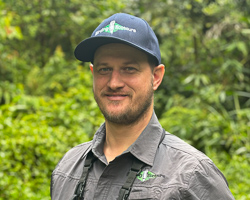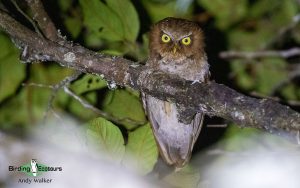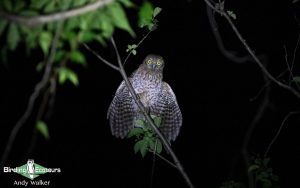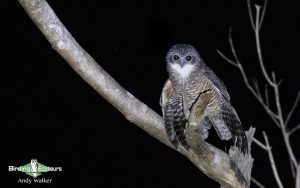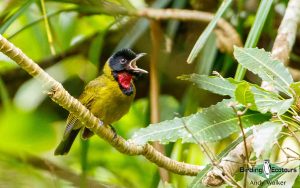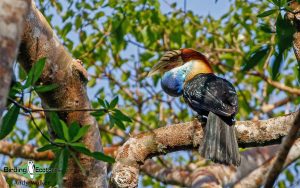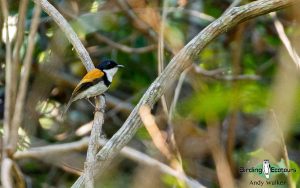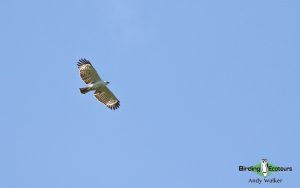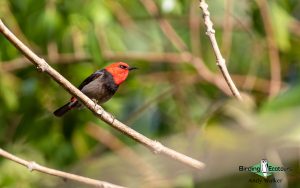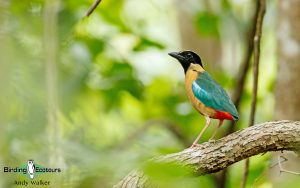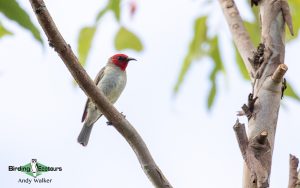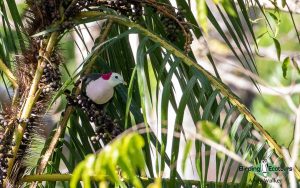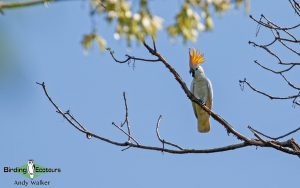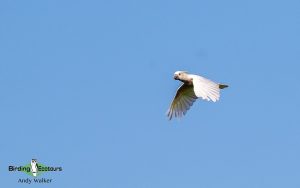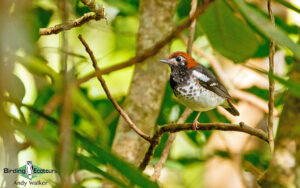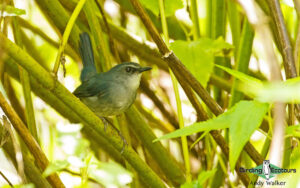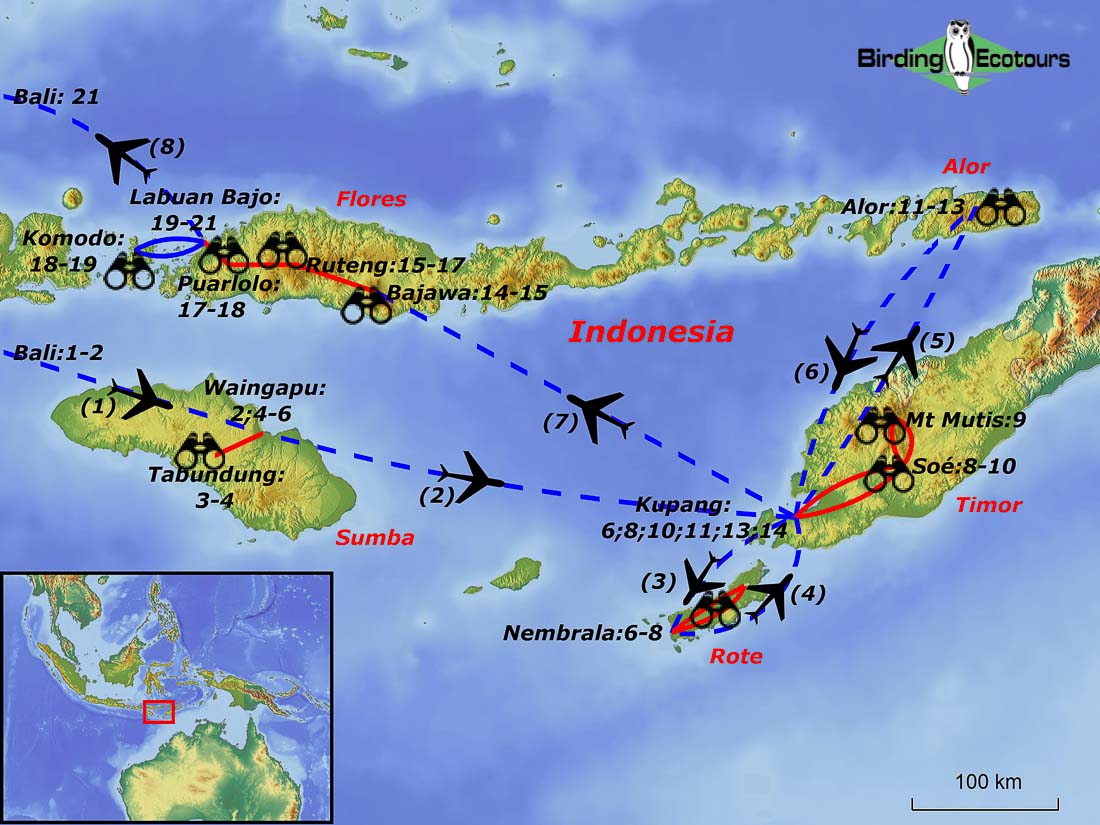Birding Tour Indonesia: The Lesser Sunda Islands– Comprehensive Tour
Go to: Indonesia Birding Tours | Birding Tours in Asia | All our birding tours
Indonesia: The Lesser Sunda Islands – Comprehensive Tour
July 2026/2027
Endemics and Specials of Sumba, West Timor, Alor, Rote, Flores, and Komodo Islands
This small-group birding tour visits six endemic-filled islands in the Lesser Sunda region of Indonesia. The tour starts and ends in Denpasar, Bali which provides an international gateway into the country before our tour will get underway, as we bird our way around the islands of Sumba, Rote, West Timor, Alor, Flores, and Komodo on what is sure to be a fascinating adventure around this rarely visited region.
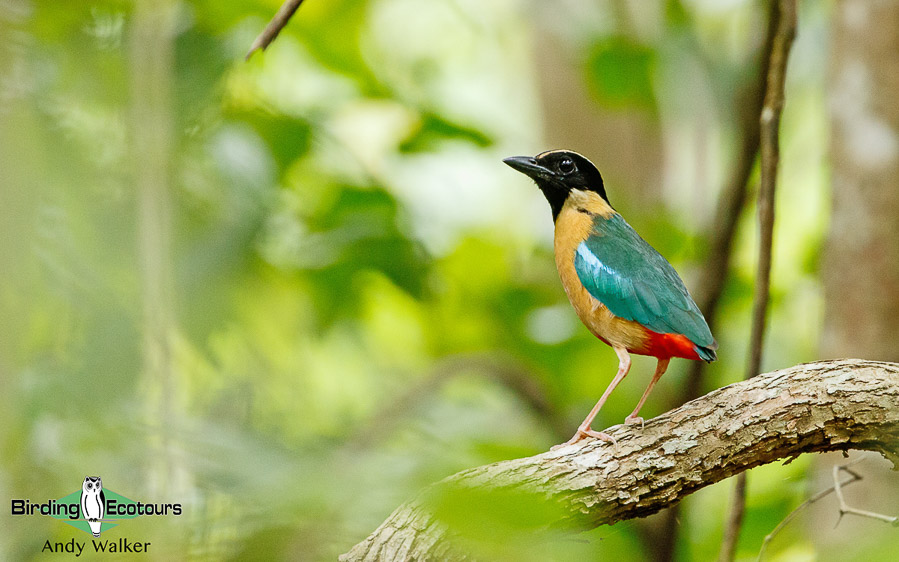
Our tour will focus on finding the island-endemic birds, regional-endemic birds, and many localized specials on offer here, such as Sumba Hornbill, Sumba Buttonquail, Cinnamon-banded Kingfisher, Least Boobook, Sumba Boobook, Sumba Eclectus, Citron-crested Cockatoo, Elegant Pitta, Red-naped Fruit Dove, Rote Boobook, Rote Myzomela, “Mt Mutis Parrotfinch” (a currently undescribed species), Black-breasted (Timor) Myzomela, Timor Imperial Pigeon, Timor Friarbird, Timor Sparrow, Orange-sided Thrush, Black-banded Flycatcher, Alor Myzomela, Alor Boobook, Flores Hawk-Eagle, Flores Scops Owl, Wallace’s Scops Owl, Chestnut-capped Thrush, Chestnut-backed Thrush, Flores Shortwing, Flores Crow, Flores Monarch, Ornate Pitta, Glittering Kingfisher, Yellow-crested Cockatoo, Sunda Pygmy Woodpecker, and many more, including an exciting range of parrots, fruit doves, sunbirds, and raptors. Komodo Dragons are likely to be a non-avian highlight when we step into a Jurassic world on the island they share their name with.
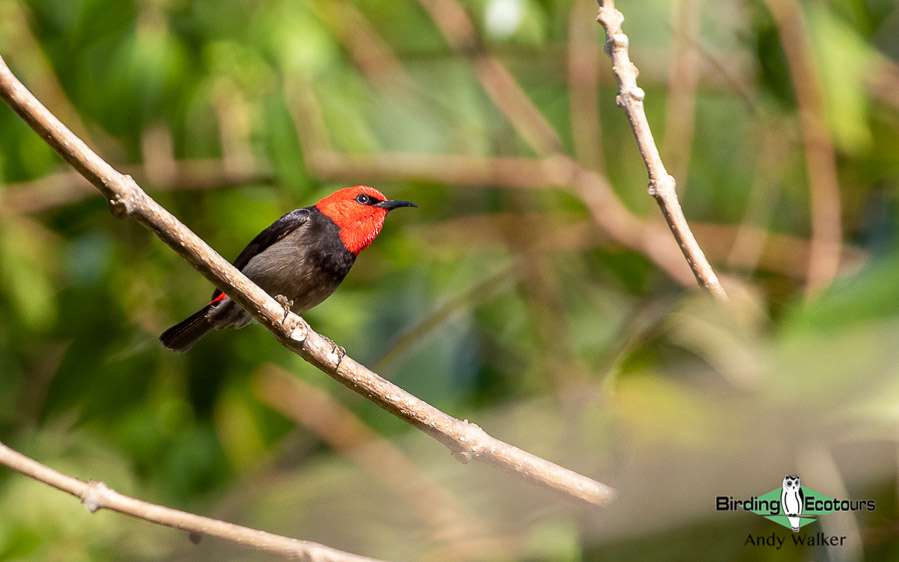
This tour can be combined with our Bali and East Java birding tour or our Sulawesi and Halmahera birding tour. Both of these birdwatching tours connect with an outrageous suite of endemic and regional specials and provides for an incredible Indonesian birding experience.
Itinerary (21 days/20 nights)
Day 1. Arrival in Denpasar (Bali)
A non-birding arrival day. You will be met at the airport and transferred to our nearby beachside hotel for the rest of the day at leisure, with a group welcome dinner in the evening.
Overnight: Mercure Bali Sanur Resort, Sanur, Bali
Day 2. Denpasar (Bali) to Tambolaka (Sumba)
We will depart Denpasar in the morning and fly to Waikabubak Airport in Tambolaka, western Sumba where we will meet our excellent local guide who will remain with us for the duration of our time in the Lesser Sundas. After clearing the airport, we will transfer to our city hotel for a couple of nights’ stay. We will spend the afternoon birding at Manurara till the evening and will look for Little Cuckoo-Dove, Sumba Green Pigeon, Black-naped Fruit Dove, Tenggara Paradise Flycatcher, Arafura Fantail, Five-colored Munia, and Sumba Boobook.
Overnight: Manandang Hotel, Waikabubak Sumba
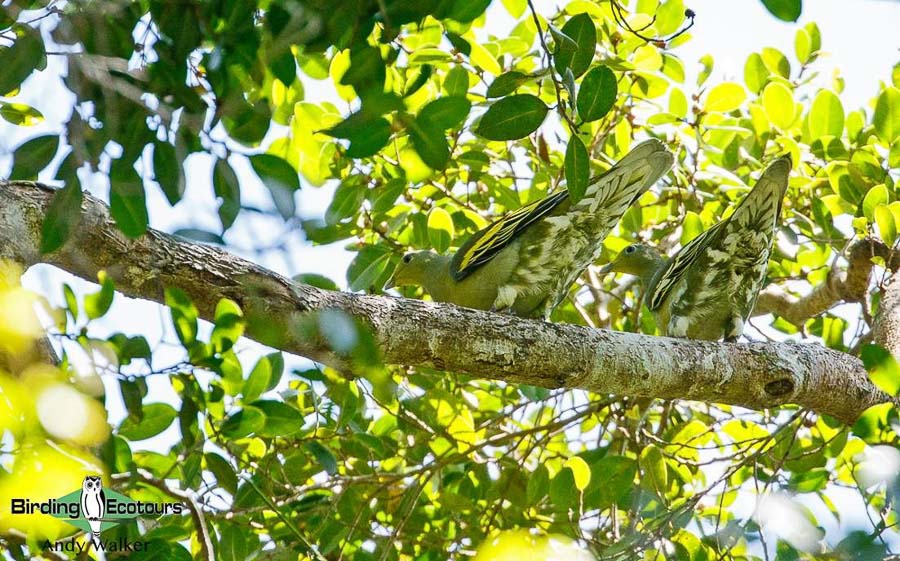
Day 3. Birding Tanadaru (Sumba)
We will leave our accommodation early and drive east. We will spend the morning birding at Tanadaru looking for more endemics and specials, such as Sumba Myzomela, Tenggara Paradise Flycatcher, Sumba Brown Flycatcher, Rusty-breasted Whistler, Marigold Lorikeet, Sumba Eclectus, Red-naped Fruit Dove, and others such as Elegant Pitta, Chestnut-backed Thrush, and Sumba Jungle Flycatcher.
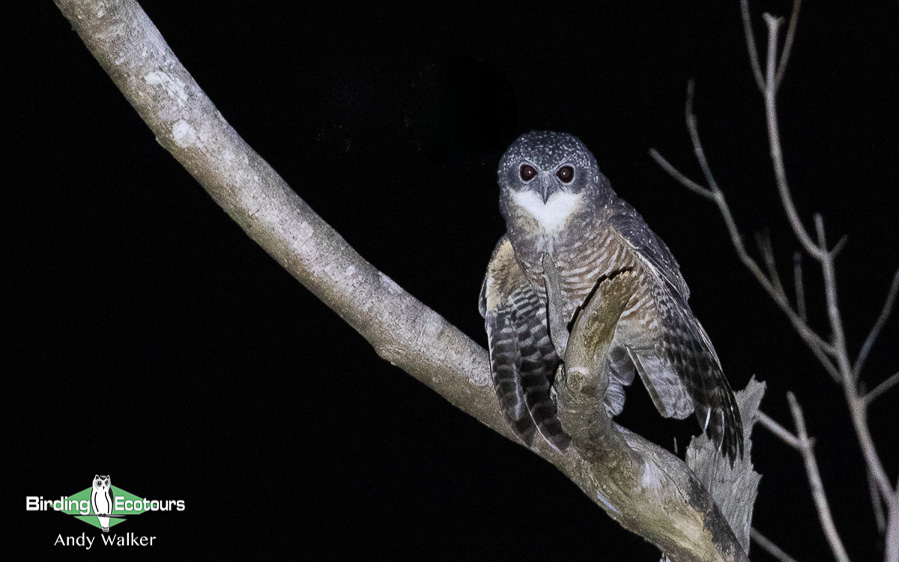
We will have lunch in a local restaurant in Langgaliru and will then continue birding near Tanadaru, where we might find Red-naped Fruit Dove, Elegant Pitta, or Sumba Myzomela. At night we will go out to try and find the endemic owl duo of Least Boobook and Sumba Boobook.
Overnight: Manandang Hotel, Waikabubak Sumba
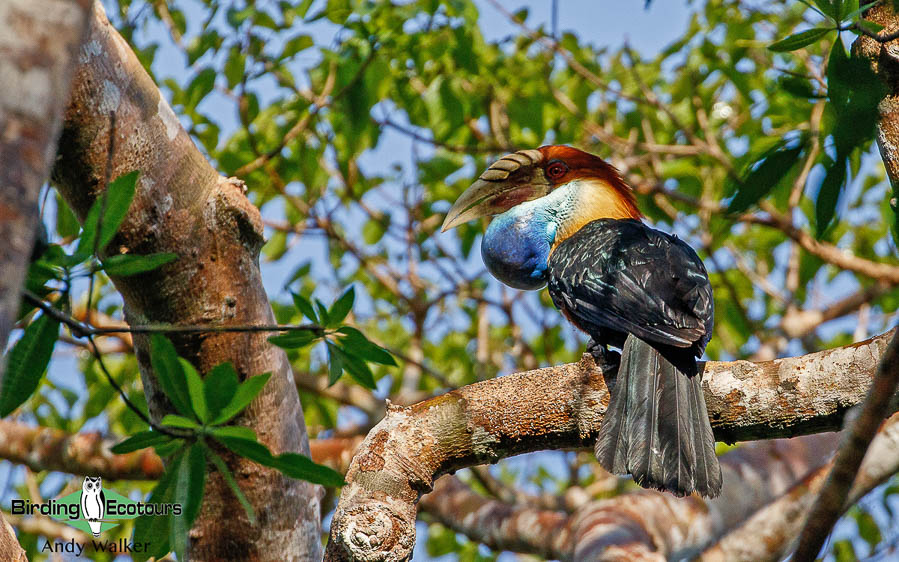
Day 4. Waikabubak to Tanadaru and on to Waingapu (Sumba)
We will head back to the Tanadaru area for the morning and will also bird around Langgaliru and Lewa, before driving across the island to Waingapu. During our birding we will look for Apricot-breasted Sunbird, Sumba Flycatcher, Red-naped Fruit Dove, Cinnamon-banded Kingfisher, Citron-crested Cockatoo (recently split from Yellow-crested Cockatoo), Elegant Pitta, Wallacean (Sumba Spangled) Drongo, and plenty more.
Overnight: Padadita Hotel, Sumba
Day 5. Birding at Laipori and Mengitimbi Lake
The main focus of today will be finding the Sumba Buttonquail. This is one of the rarest and the toughest endemics on the island, so we will need to put in some effort to locate it. Other possibilities that are usually present in the buttonquail area include, Javan Plover, Spotted Kestrel, Brown (Indonesian) Honeyeater, Zitting Cisticola, Striated Swallow, Five-colored Munia, and Pale-headed Munia.
Overnight: Padadita Hotel, Sumba
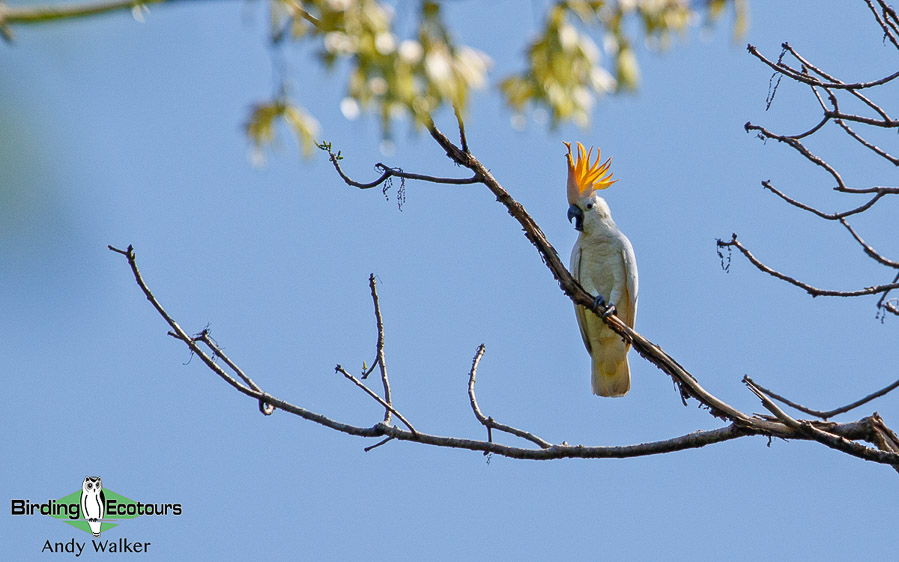
Day 6. Waingapu (Sumba) to Kupang (Timor) to Onotali (Rote)
Essentially a travel day as we firstly take a morning flight from Waingapu, Sumba to Kupang, Timor before completing our journey with a short flight to Bandar Udara D. C. Saudale Airport, Rote. Once we have cleared the airport, we will check into our nearby basic hotel in the small town of Onotali. Depending on flight schedules, there may be time for some birding in Kupang, Timor (though we will be back here in a few days), or near our accommodation in Sumba or in Rote either side of our flights. We should look out for Australian Pratincoles on the airport runways here too!
Overnight: Hotel Ricky, Onotali, Rote
Day 7. Rote birding (Rote)
We will have the full day birding on Rote. We will spend the morning birding at Baudale and Peto Lake, dropping back into town for lunch, before driving across to Bolatena for an afternoon and evening birding session. During the course of the day we will be looking for Rote endemics and specials such as Rote Myzomela, Rote Leaf Warbler, Timor Green Pigeon, Banded (Black-backed) Fruit Dove, Pink-headed Imperial Pigeon, Jonquil Parrot, Northern (Rote) Fantail, Black (Slaty) Cuckoo-Dove, Olive-brown (Timor) Oriole, Helmeted (Tenggara) Friarbird, Orange-sided Thrush, Timor Blue Flycatcher, White-bellied (Timor) Bush Chat, Flame-breasted Sunbird, and Timor Stubtail. In the evening we will look for the endemic Rote Boobook, along with the undescribed “Timor Nightjar” that can be found on the island.
Overnight: Hotel Ricky, Onotali, Rote
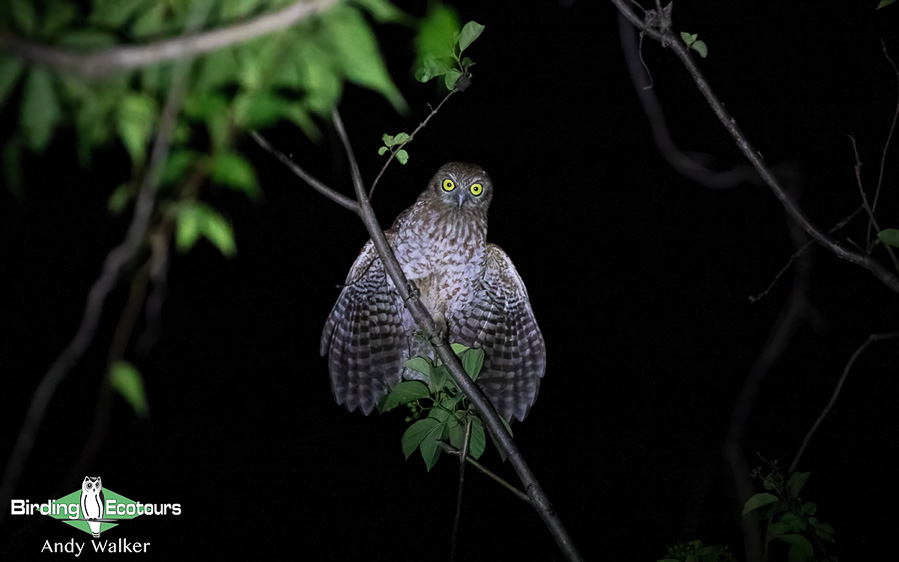
Day 8. Rote to Kupang (Timor) to Soé (Timor)
We will take a morning flight from Rote back to Kupang, from where we will drive to Soé. The plan will be to stop and look for birds along the road at Fatuleu, with targets including Black-banded Flycatcher and Timor Blue Flycatcher. Here we may also find Timor Friarbird, Rose-crowned Fruit Dove, Cinnamon-banded Kingfisher, and Orange-sided Thrush. In the afternoon we will visit Oehala waterfall which can sometimes produce Black-breasted (Timor) Myzomela, Fawn-breasted Whistler, and Northern (Timor) Fantail.
Overnight: Hotel Bahagia 2, Soé, Timor
Day 9. Birding Gunung Mutis (Timor) – in search of the undescribed parrotfinch!
We will spend the full day birding Gunung Mutis, home to some little-known and exciting birds, such as the currently undescribed parrotfinch, known as “Mt Mutis Parrotfinch”, which we will hope to see. While here we will be looking for many target species, such as Timor Imperial Pigeon, Banded (Black-backed) Fruit Dove, Black-breasted (Timor) Myzomela, Flame-eared Honeyeater, Plain (Timor) Gerygone, Timor Leaf Warbler, Timor Blue Flycatcher, Snowy-browed Flycatcher, Blood-breasted (Timor) Flowerpecker, Sunda Thrush, Chestnut-backed Thrush, Island Thrush, Pygmy Cupwing, Lesser Shortwing, and Yellow-throated Whistler.
Overnight: Hotel Bahagia 2, Soé, Timor
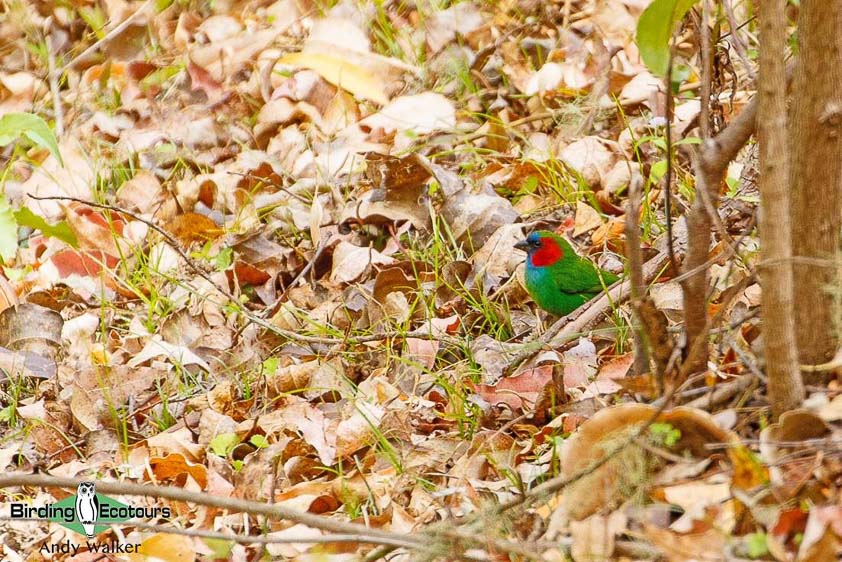
Day 10. Soé to Camplong to Bipolo to Kupang (Timor)
A morning visit to Camplong Nature Reserve is likely to offer some great birds. Highlights from here could include Timor Friarbird, Orange-sided Thrush, Black-banded Flycatcher, Iris Lorikeet, Timor Blue Flycatcher, Rose-crowned Fruit Dove, Pacific Emerald Dove, Streak-breasted Honeyeater, Brown (Indonesian) Honeyeater, Flame-eared Honeyeater, Scaly-crowned (Sunda) Honeyeater, Arafura Fantail, Northern (Timor) Fantail, Ashy-bellied White-eye, Orange-sided Thrush, Blue-cheeked Flowerpecker, Buff-banded Thicketbird, Timor Stubtail, Thick-billed (Sunda) Flowerpecker, Spot-breasted Heleia (Timor White-eye), and Timor Cuckoo-Dove.
Our afternoon birding session will take in the well-known Bipolo Forest, where we shall again seek out many of the species mentioned above. Open areas along the edge of the forest may hold the declining Timor Sparrow in among flocks of more widespread munias, as well as shorebirds like Australian Pratincole. After our birding we will continue our journey to Kupang for the night.
Overnight: Aston Hotel, Kupang, Timor
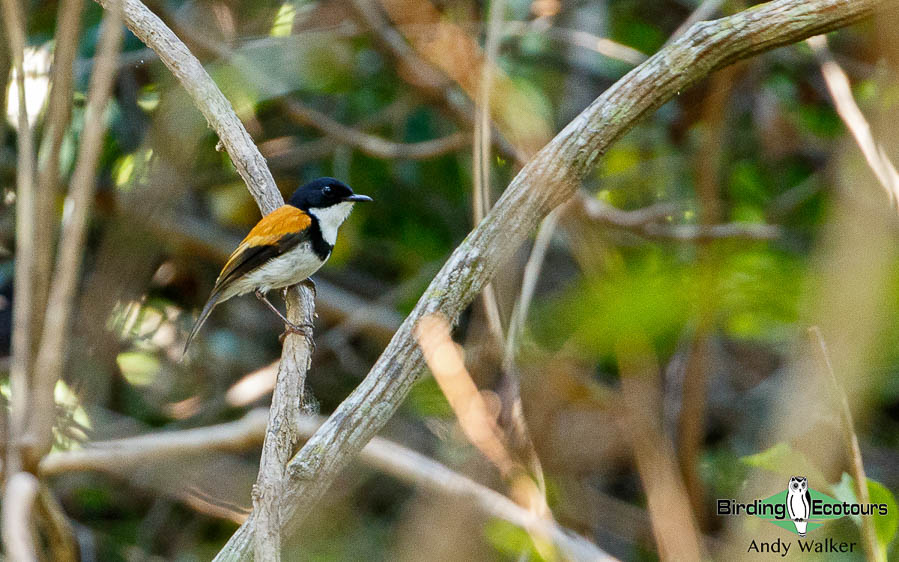
Day 11. Kupang (Timor) to Alor (Alor)
We will take our morning flight to the small island of Alor before we spend our day exploring this rarely visited island. We will make a stop at the Takpala traditional village to enjoy some hospitality and dancing prior to visiting the Hutan Nostalgia Nature Reserve for some birding. Here we hope to find Olive-headed Lorikeet, Timor Cuckoo-Dove, Little (Eucalypt) Cuckoo-Dove, and Spotted Kestrel. If time permits, we may make our first attempt to find the endemic Alor Boobook in the evening.
Overnight: Hotel Simfony, Alor
Day 12. Alor birding (Alor)
We will spend the full day birding at a range of sites around Alor, where we will seek out Alor Myzomela, Wallacean (Alor) Cuckooshrike, Flores Green Pigeon, Aberrant (Sunda) Bush Warbler, Javan (Timor) Bush Warbler, Lesser Shortwing, Flores Hawk-Eagle, Short-toed Snake Eagle, Bonelli’s Eagle, Timor Stubtail, Thick-billed (Tenggara) Flowerpecker, Blood-breasted (Timor) Flowerpecker, Tenggara Hill Myna, Chestnut-backed Thrush, and plenty more. In the evening we will search for Alor Boobook, Eastern Barn Owl, and Mees’s Nightjar.
Overnight: Hotel Simfony, Alor
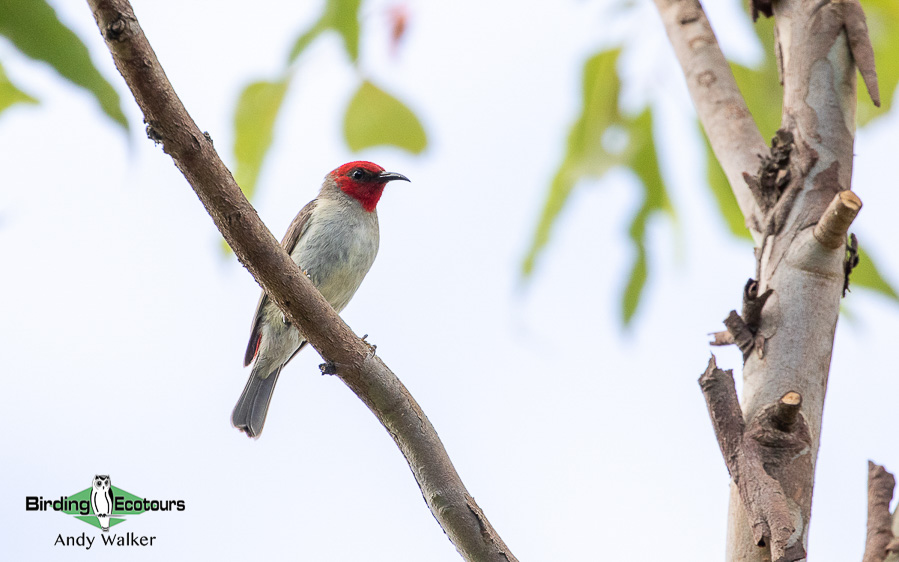
Day 13. Alor to Kupang (Timor)
We will take a morning flight from Alor back to Kupang, Timor and will check into our hotel. Once the heat of the day has passed, we will spend the late afternoon visiting some mangroves and farmland near Bipolo Forest, where we will look for Timor Sparrow, Sunda Zebra Finch, Timor Friarbird, and Black Kite, we may also find some resident, over-summering Palearctic, or over-wintering Australasian shorebirds, or Timor Boobook at dusk.
Overnight: Aston Hotel, Kupang, Timor
Day 14. Kupang (Timor) to Bajawa (Flores)
Leaving Timor for the final time we will take the short flight to Flores (Bajawa Airport) in Soá. If time permits, we will call into the nearby hot springs before having lunch in Bajawa. After lunch we will stop to visit Bena traditional village and we will follow this up with some birding around Inerie Volcano. Here our targets will include Flores Green Pigeon, Black-naped (Nusa Tenggara Golden) Oriole, Scaly-crowned Honeyeater, Leaf (Flores) Lorikeet, and Chestnut-backed Thrush.
Overnight: Sanian Hotel, Bajawa, Flores
Day 15. Bajawa to Kisol to Ruteng (Flores)
An early start will see us heading to the famous site of Poco Ndeki (Kisol). The remnant lowland forest here holds the majority of the lowland endemics found on Flores. Our main targets here will include Flores Green Pigeon and Flores Crow but many other endemics and specials occur, and could include Flores Hawk-Eagle, Wallace’s Scops Owl, Glittering Kingfisher, Chestnut-capped Thrush, Ornate Pitta, Yellow-ringed White-eye (Wallace’s Heleia), Crested White-eye (Heleia), Thick-billed Heleia, Leaf (Flores) Lorikeet, Great-billed Parrot, and Russet-capped Tesia. In the afternoon we will drive to Ruteng where in the evening we will take a night walk looking for the rare Flores Scops Owl, a tough but exciting bird.
Overnight: Ara Garden, Ruteng, Flores
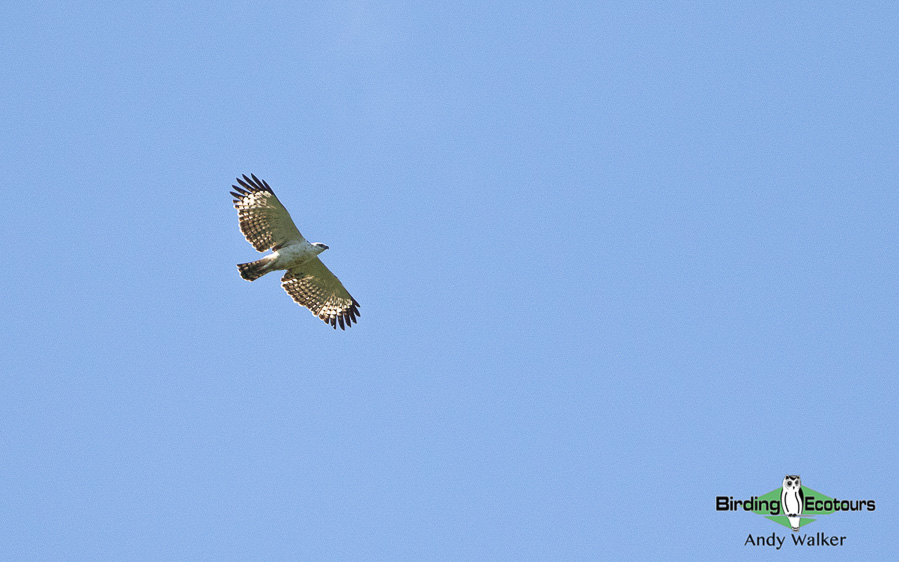
Day 16. Birding Ruteng Nature Reserve and Golo Lusang (Flores)
We may make an early start (depending on the previous evening’s owling session) and will look for Flores Scops Owl again, if needed, along with other targets such as the difficult Wallace’s Scops Owl, Bare-throated Whistler (the song of this one will blow your mind!), Flores Shortwing, Flores Jungle Flycatcher, Crested White-eye (Heleia), Little (Flores) Minivet, Golden-rumped Flowerpecker, Pale-shouldered Cicadabird, and Chestnut-backed Thrush.
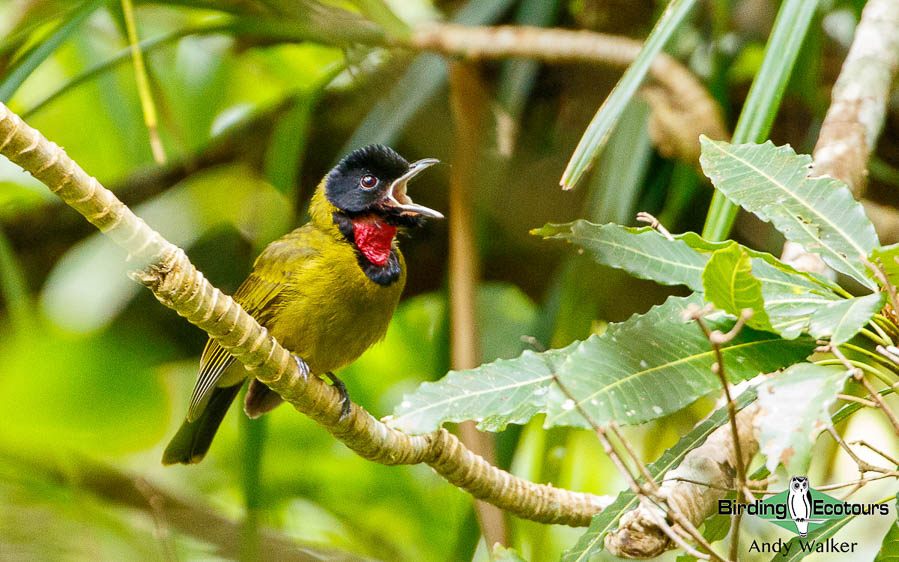
Day 17. Ruteng to Puarlolo (Flores)
We will leave Ruteng to the west and will reach Puarlolo, where a trail through some secondary hill forest will present us with a great opportunity to find the rare, range-restricted endemic Flores Monarch. Here we can find plenty of other exciting species too, such as the gorgeous Chestnut-capped Thrush, Chestnut-backed Thrush, Flores Crow, Wallace’s Hanging Parrot, Green Junglefowl, Black-naped Fruit Dove, Glittering Kingfisher, Red-cheeked Parrot, Ornate Pitta, Helmeted (Tenggara) Friarbird, Rusty-breasted Whistler, Tenggara Paradise Flycatcher, Russet-capped Tesia, Rufous-chested Flycatcher, Golden-rumped Flowerpecker, and Thick-billed (Tenggara) Flowerpecker.
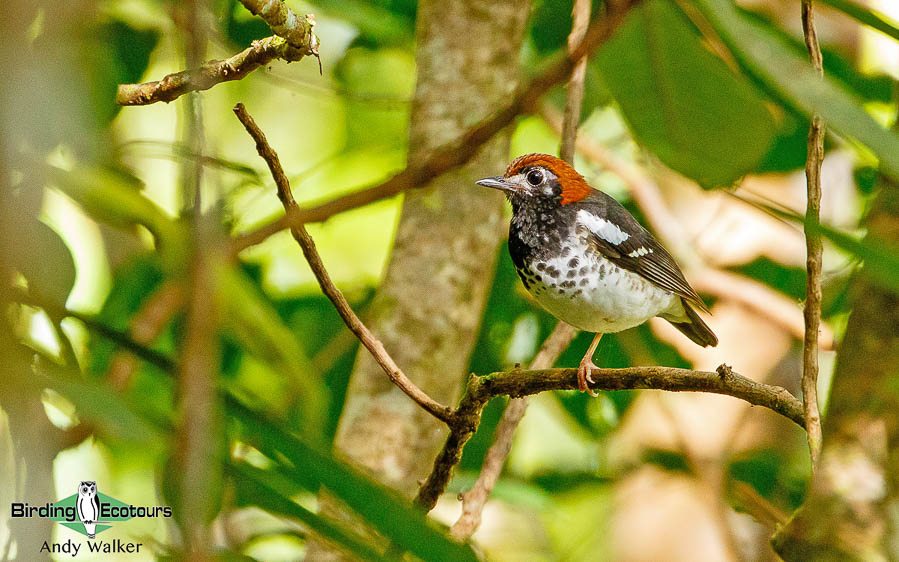
We will continue to Ndengo village for lunch and in the afternoon we may visit Cunca Rami waterfall, if time allows. We will spend the late-afternoon birding around the grounds of our comfortable ecolodge where we could see Wallacean Drongo, Ruddy (Parzudaki’s) Cuckoo-Dove, Collared Kingfisher, Glittering Kingfisher, Tenggara Swiftlet, Oriental Dollarbird, Blue-tailed Bee-eater, Sunda Pygmy Woodpecker, Black-naped Monarch, Tenggara Paradise Flycatcher, and Black-fronted Flowerpecker.
Overnight: Mbeliling Ecolodge, Mbeliling, Flores
Day 18. Puarlolo to Labuan Bajo (Flores) to Komodo Island (Komodo)
We will spend the early morning back in the forest at Puarlolo, looking for some of the species mentioned above. Once we check out from our accommodation, we will wind our way down and off the mountain, to the town of Labuan Bajo. Here, we will go directly to the pier to meet our air-conditioned cabin boat to take us to Komodo National Park (having lunch on the way), maybe seeing Lesser Frigatebird, Bridled Tern, Black-naped Tern, White-bellied Sea Eagle, Beach Stone-curlew, or Great-billed Heron along the way. In the afternoon we will stop at Pink Beach for some swimming and snorkeling. We will spend the night on the boat, near the pier of Komodo Island, ready for the following morning.
Overnight: Cabin Boat, Komodo
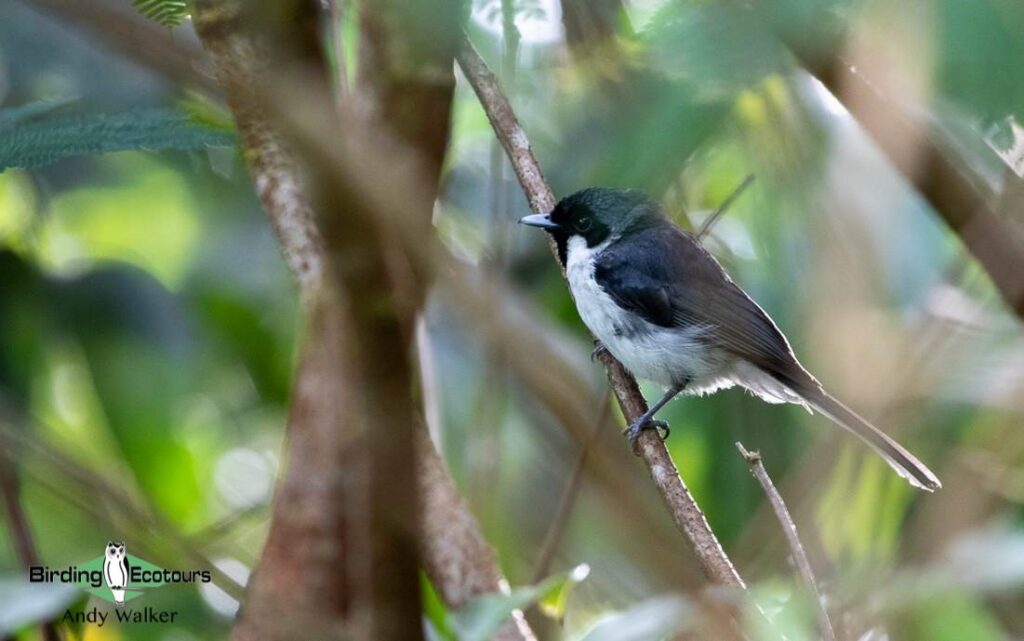
Day 19. Birding Komodo Island (Komodo) to Labuan Bajo (Flores)
The morning will be spent birding in Komodo National Park, this protected island is a haven for wildlife and a joy to visit in a country so plagued by habitat destruction, illegal hunting, and bird trapping practices. Walking around the island we will see a range of birds all over the place. Our main avian target will be the rare Yellow-crested Cockatoo. Komodo Island now represents the best place in the world to see this Critically Endangered (BirdLife International) species.
There are other birds we will look for on Komodo Island too, such as Flores Hawk-Eagle, Variable (Nusa Tenggara) Goshawk, Orange-footed Scrubfowl, Green Junglefowl, Green Imperial Pigeon, Pied Imperial Pigeon, Sunda Collared Dove, Barred Dove, Black-naped (Nusa Tenggara Golden) Oriole, Wallacean (Flores) Cuckooshrike, Wallacean (Flores Spangled) Drongo, Striated Swallow, Helmeted (Tenggara) Friarbird, and Lemon-bellied White-eye. One of the main reasons for coming to Komodo Island, however, is to look for the impressive Komodo Dragon, a giant monitor lizard that can reach lengths of up to almost 10 feet (3 meters); pretty much the closest you can come to a dinosaur in this day and age!
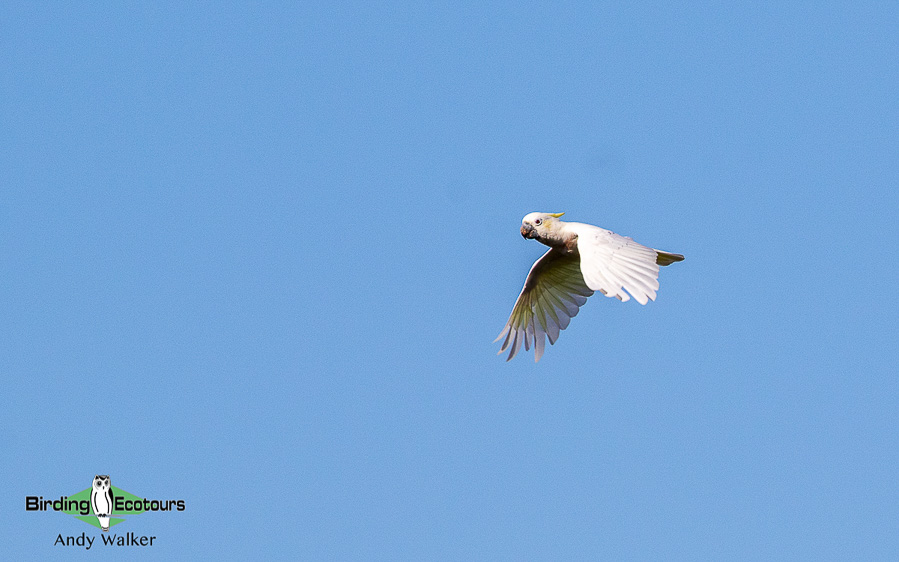
We will sail away from Komodo Island and have lunch on the boat. We will then likely stop for some more swimming and snorkeling around Pink Beach or another reef site nearby. The reef life in this part of Indonesia is fascinating and we really recommend exploring it on this tour. In the late afternoon we will arrive at our comfortable beachside hotel in Labuan Bajo.
Overnight: Purisari Beach Hotel, Labuan Bajo
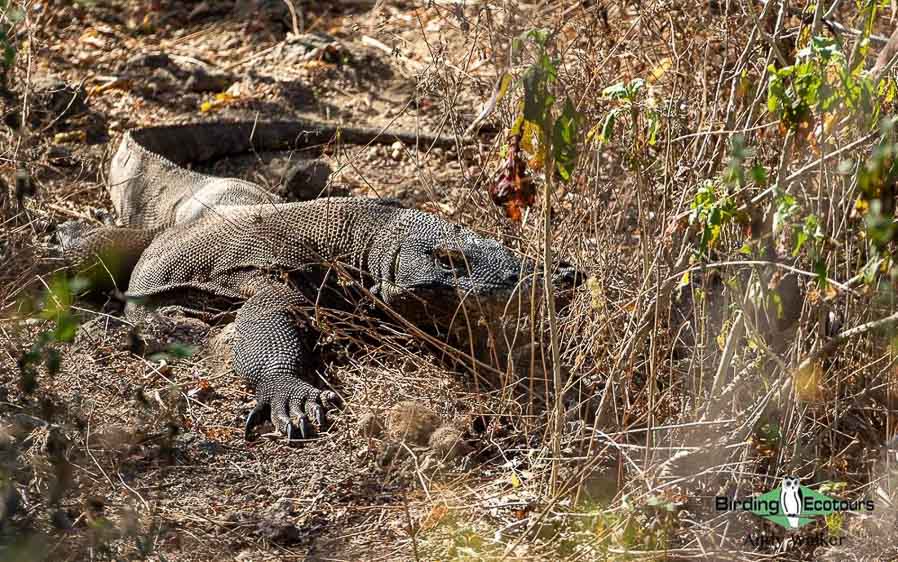
Day 20. Birding Potawangka and birding Labuan Bajo (Flores)
Our final morning birding session of the tour will take us to some forest not too far out of Labuan Bajo, here we will have further opportunities for species such as Flores Monarch, Wallace’s Hanging Parrot, Variable (Nusa Tenggara) Goshawk, Bonelli’s Eagle, Glittering Kingfisher, Ornate Pitta, Wallacean (Flores) Cuckooshrike, Black-naped Monarch, Rusty-breasted Whistler, and Yellow-ringed White-eye (Wallace’s Heleia).
Afternoon birding will take us to some nearby rice paddies, seasonal wetlands, and shrimp ponds, where we will likely see some different birds, such as Sunda Teal, Wandering Whistling Duck, Javan Plover, Malaysian Plover, Beach Stone-curlew, Buff-banded Rail, White-browed Crake, Australasian Swamphen, White-shouldered Triller, Pied Bush Chat, Flame-breasted Sunbird, Black-fronted Flowerpecker, Black-faced Munia, Sunda Zebra Finch, Stork-billed Kingfisher, Collared Kingfisher, Sacred Kingfisher, and Cerulean Kingfisher. We will have a final group evening meal together and discuss the ‘bird of the trip’, not likely to be an easy task, given the number of exciting species we are likely to have found!
Overnight: Purisari Beach Hotel, Labuan Bajo
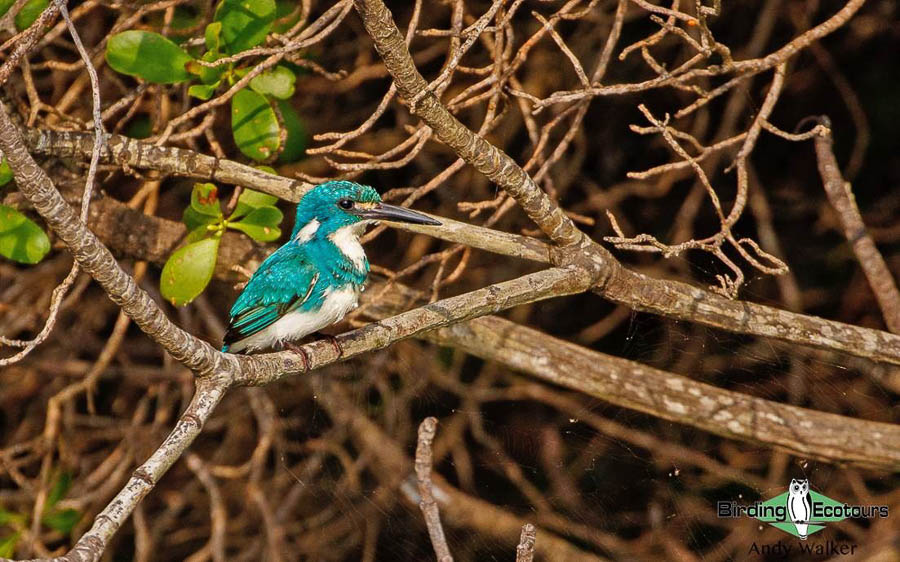
Day 21. Labuan Bajo (Flores) to Denpasar (Bali) where the tour concludes
A non-birding day. After a leisurely breakfast at our comfortable beachside hotel, we will take a late morning flight back to Denpasar in Bali, where the tour will end with your international departure. Please do not book your international flight prior to us confirming the time of the domestic flight between Labuan Bajo and Denpasar.
Overnight: Not included
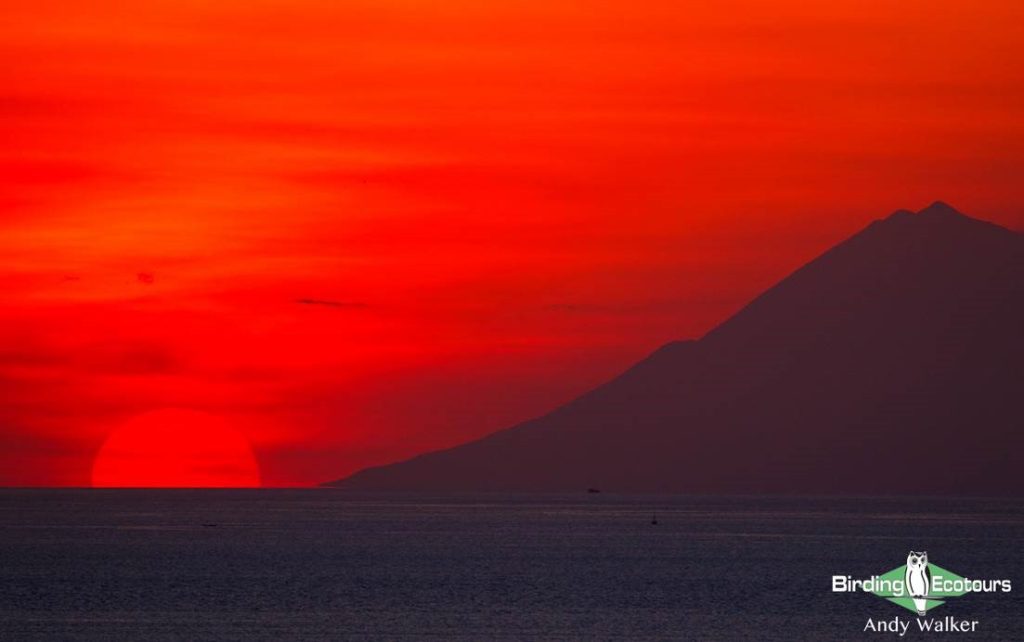
Please note that the itinerary cannot be guaranteed as it is only a rough guide and can be changed (usually slightly) due to factors such as availability of accommodation, updated information on the state of accommodation, roads, or birding sites, the discretion of the guides and other factors. In addition, we sometimes have to use a different international guide from the one advertised due to tour scheduling.
Download ItineraryIndonesia: The Lesser Sunda Islands – Comprehensive Tour Trip Report
20 JUNE – 10 JULY 2022
By Andrew Walker
DOWNLOAD TRIP REPORT
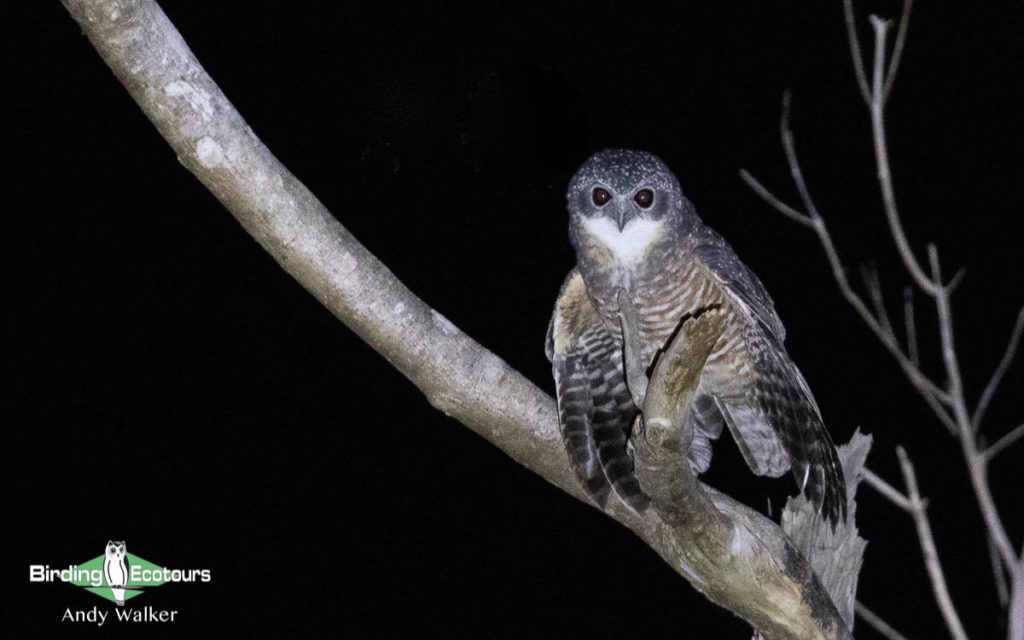
Overview
This Indonesian bird tour covered a wide selection of Lesser Sunda islands, starting and ending in Bali and visiting Sumba, Rote, Timor, Alor, Flores, and Komodo. The tour focused on the regional endemic and special birds, with plenty of highlights along the way. We recorded 215 species on the tour (seven of these heard only). The taxonomy of the region still requires a lot of work and we saw many subspecies during the tour that could be elevated to full species status in the future. The list of highlights was very long and included Flores Scops Owl, Sumba Boobook, Little Sumba Hawk-Owl, Rote Boobook, Timor Boobook, Flores Hawk-Eagle, Sumba Hornbill, Yellow-crested Cockatoo, Elegant Pitta, Ornate Pitta, Red-naped Fruit Dove, Timor Imperial Pigeon, Timor Cuckoo-Dove, Bare-throated Whistler, Buff-banded Thicketbird, Flores Monarch, Little (Flores) Minivet, Rote Leaf Warbler, Timor Leaf Warbler, Flores Leaf Warbler, White-browed (Flores) Shortwing, Black-banded Flycatcher, Timor Blue Flycatcher, Sumba Myzomela, Rote Myzomela, Black-breasted (Timor) Myzomela, Alor Myzomela, and Timor Sparrow. Non-avian highlight was easily Komodo Dragon!
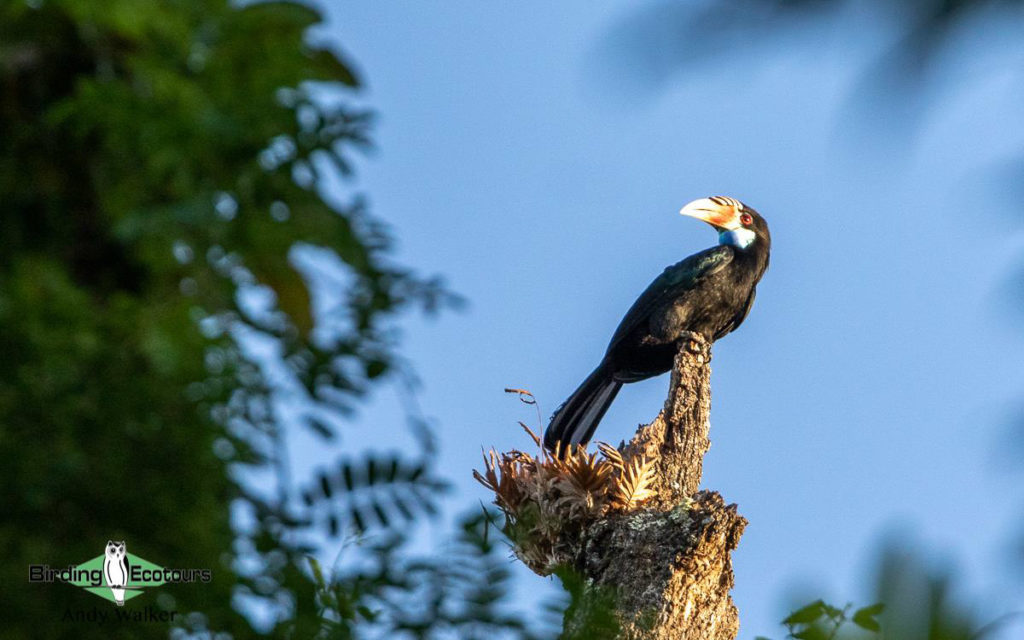
Detailed Report
Day 1, 20th June 2022. Arrival in Bali, Indonesia
An arrival day in Denpasar, Bali. For those that arrived a little earlier a trip to Bedugul Botanical Gardens was the order of the morning with plenty of interesting birds found, including Blood-breasted (Javan) Flowerpecker, Mees’s White-eye, Flame-fronted Barbet, and Black-winged Flycatcher Shrike (birds from this day are not included in the trip list but can be seen on eBird, here). By late afternoon the whole group had arrived and we enjoyed our welcome dinner together on the beach as the sun set, with the sound of Savanna Nightjars calling overhead.
Day 2, 21st June 2022. Travel to Tambolaka, Sumba
After a leisurely breakfast we took the short drive from our beachside Bali resort to the airport in Denpasar where we checked in for our flight to Tambolaka, Sumba. All went smoothly and we even had a couple of Australian Pratincole on the runway! After our arrival in Tambolaka we met our local guide Yovie and commenced our journey to Waikabubak. Nearby, a roadside birding session yielded Blood-breasted (Sumba) Flowerpecker, Black-naped Fruit Dove, Apricot-breasted Sunbird, Yellow-ringed White-eye, and Tenggara Paradise Flycatcher which provided a great introduction to birding on the island.
Day 3, 22nd June 2022. Birding Sumba
An early start walking along a ridgeline near Waikabubak provided some early highlights, with some of the group getting excellent views of Mees’s Nightjar. Several parrot species were flying around, and included Great-billed Parrot, Marigold Lorikeet, Red-cheeked Parrot, and a distant Yellow-crested (Orange-crested) Cockatoo which perched briefly. A pair of Pale-shouldered Cicadabirds moved through, the male giving some excellent close views, while Helmeted (Tenggara) Friarbirds teased us as they moved around in shady spots. Flowerpeckers and sunbirds were abundant, and we got excellent views of Thick-billed (Tenggara) Flowerpecker, Blood-breasted (Sumba) Flowerpecker, and Apricot-breasted Sunbird.
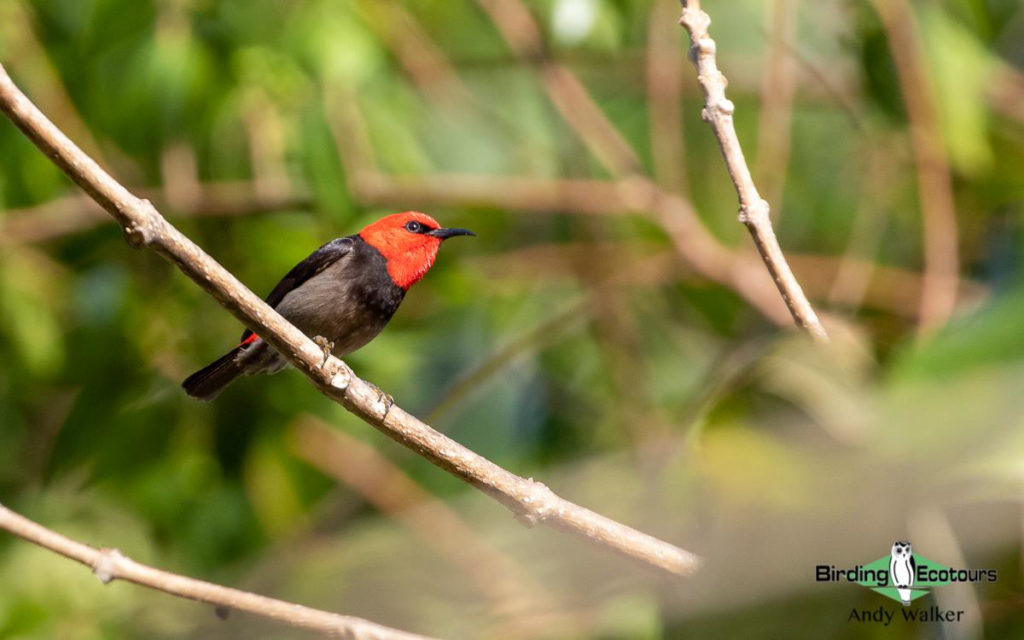
We had some excellent and prolonged views of a singing male Sumba Brown Flycatcher, which was a real treat. While watching the flycatcher we had displaying and perched Green Imperial Pigeons, and Sumba Green Pigeon. Frustratingly, Nicobar Pigeon, Black-naped Fruit Dove, and Common Emerald Dove views were very brief and not seen by everyone. A few singing Elegant Pittas were heard, and we got great looks at Arafura (Supertramp) Fantail, Rusty-breasted Whistler, Tenggara Paradise Flycatcher, Grey-headed Canary-flycatcher, Wallacean (Sumba Spangled) Drongo, and Yellow-ringed White-eye.
White-faced Heron, Eastern Cattle Egret, Blue-tailed Bee-eater, Brahminy Kite, and Brown Goshawk were all noted flying overhead, as were Tenggara Swiftlet and Edible-nest Swiftlet.
Our afternoon birding session took us to a slightly different area, and we were rewarded with simply excellent views of Red-naped Fruit Dove, followed by Sumba Myzomela, Marigold Lorikeet, Eclectus Parrot, and on dusk, Little Sumba Hawk-Owl which gave great views.
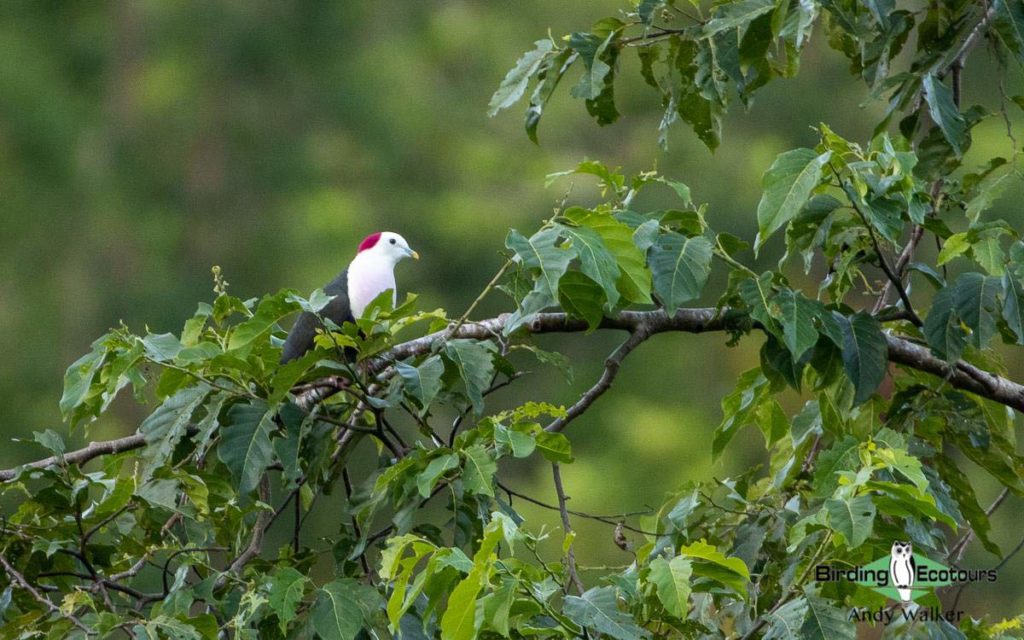
Day 4, 23rd June 2022. Birding Sumba
A very long day today, as we made our way from the western to eastern side of the island, but one that was packed full of amazing Sumba endemics. The day started with us staking out a viewpoint where we were rewarded with excellent views of a pair of stunning Sumba Hornbills.
Here we also found several other goodies, such as Red-naped Fruit Dove, Sumba Green Pigeon, Marigold Lorikeet, Red-cheeked Parrot, Great-billed Parrot, Spectacled Monarch, Ashy-bellied White-eye, and Rusty-breasted Whistler. Moving around the general area we found Sumba Flycatcher, Sumba Jungle Flycatcher, Sumba Myzomela, Wallacean (Sumba) Cuckooshrike, Tenggara Paradise Flycatcher, and everyone got to see Elegant Pitta.
Our lunch and rest stop over the middle of the day proved to be an excellent raptor-watching spot and we saw Bonelli’s Eagle, Short-toed Snake Eagle, Black-winged Kite, Spotted Harrier, Brown Goshawk, and Spotted Kestrel.
Our birding ended with a roadside stop where we were rewarded with excellent views of Sumba Boobook, the final endemic species we needed on the island!
Day 5, 24th June 2022. Birding Sumba
A relaxing day after the long day yesterday. We had a late breakfast and followed that with some morning birding in some wetlands near our hotel. Here we found Javan Plover, Wandering Whistling Duck, Australian Swamphen, Intermediate Egret, Javan Pond Heron, Purple Heron, Javan Munia, Pale-headed Munia, Sunda Zebra Finch, and several other common and widespread species.
The afternoon was spent at leisure around our beachside resort.
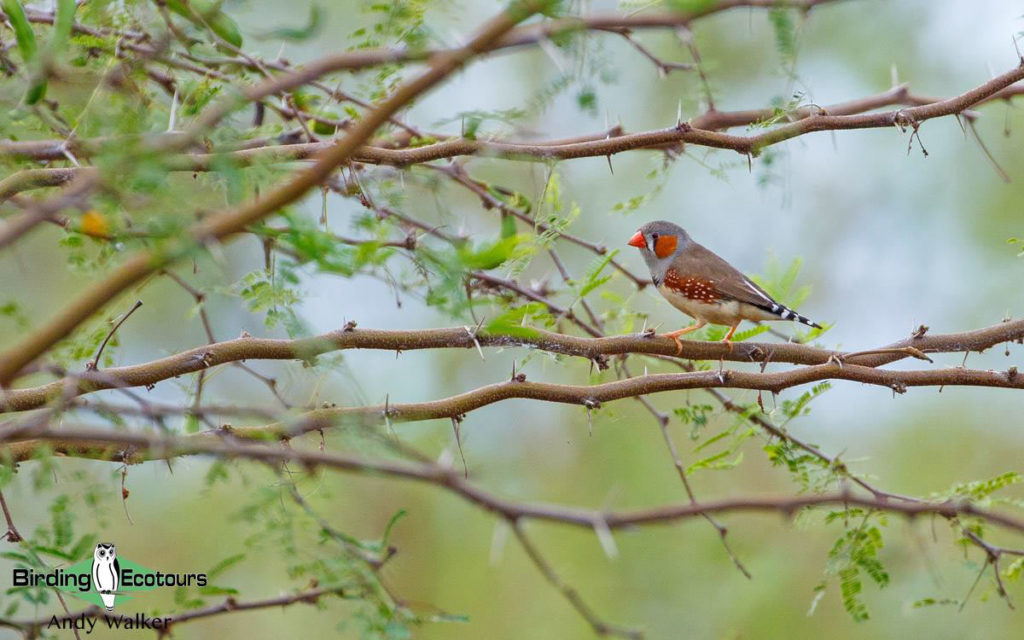
Day 6, 25th June 2022. Waingapu (Sumba) to Kupang (Timor) to Onotali (Rote)
Essentially a travel day as we made our way from Sumba to Rote, via Kupang in Timor. An early start from Waingapu saw us arriving and grabbing breakfast in Kupang. Some rice paddies and coastal birding in the late morning near Kupang provided us with views of Tree Martin, Drab Swiftlet, Pale-headed Munia, Australian Pratincole, Australian Tern, Greater Crested Tern, Lesser Crested Tern, Little Tern, Greater Sand Plover, and Grey-tailed Tattler.
After a very nice lunch we headed back to the airport for our short hop across to the small island of Rote where we were to spend the next two nights. The sight of over 100 Australian Pratincoles on the airfield on arrival in Rote was impressive.
Day 7, 26th June 2022. Birding Rote
A relaxed start to the day saw us heading to a small patch of forest in the north of the island where we immediately found some great endemic birds. Rote Myzomela was the first to show, and then Rote Leaf Warbler came quickly afterwards, then followed Northern (Rote) Fantail, Plain (Timor) Gerygone, White-bellied (Timor) Bush Chat, Fawn-breasted Whistler, and then the stunning quartet of Orange-sided Thrush, Timor Blue Flycatcher, Flame-breasted Sunbird, and Blue-cheeked (Red-chested) Flowerpecker.
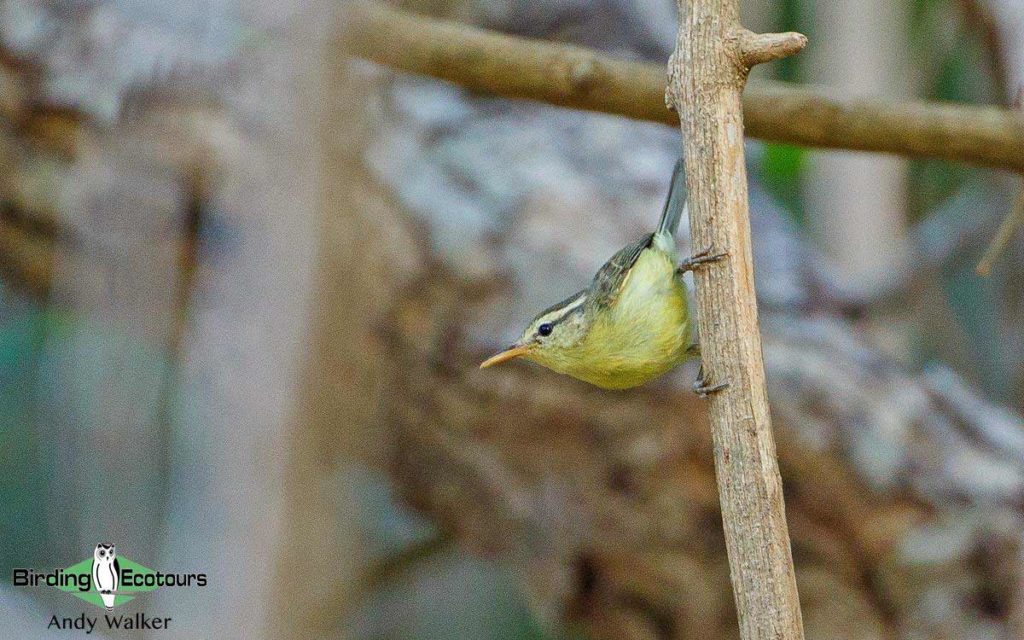
In the afternoon we took a drive to the north of the island where a couple of stops near some lakes provided views of Red-capped Plover, Pied Stilt, Wandering Whistling Duck, Sunda Teal, Tricolored Grebe, White-browed Crake, Whiskered Tern, Rainbow Bee-eater, Sacred Kingfisher, Common Kingfisher, and several passerines such as White-bellied (Timor) Bush Chat, Arafura (Supertramp) Fantail, Broad-billed Flycatcher, and Five-colored Munia.
As dusk approached, we made our way to the forest to look for our final Rote endemic, and after a bit of cat-and-mouse we were rewarded with great views of Rote Boobook, one very impressive bird.
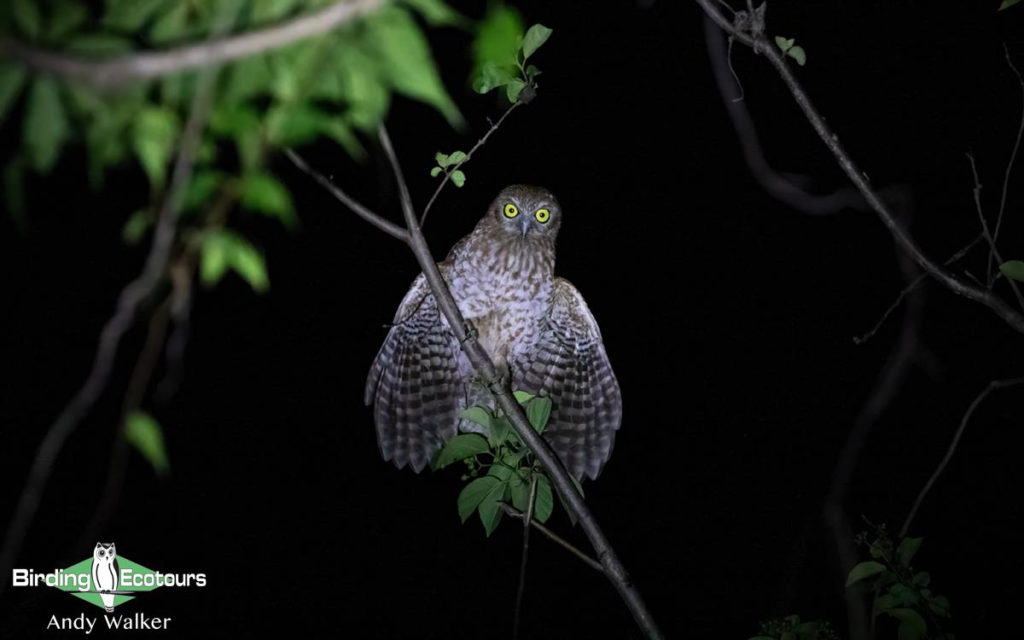
Day 8, 27th June 2022. Rote to Kupang (Timor) then on to Soé, Timor
An early flight saw us at Rote airport at dawn, complete with a Savanna Nightjar and flock of Australian Pratincoles on the runway. We arrived in Kupang, Timor and had breakfast before driving east across Timor to the town of Soé. In the afternoon we visited a forest, where we found Black-breasted (Timor) Myzomela, Timor Imperial Pigeon, Rose-crowned Fruit Dove, Northern (Timor) Fantail, Buff-banded (Timor) Thicketbird, Streak-breasted Honeyeater, Plain (Timor) Gerygone, Spot-breasted (Timor) Heleia, and Tricolored Parrotfinch.
Day 9, 28th June 2022. Birding Gunung Mutis
We headed up Gunung (Mount) Mutis in the morning but were greeted by strong wind, cold temperatures, and impending rain (which after a while did come). It was not as productive as usual at the site due to the weather conditions, compounded by a local guy hunting birds throughout the site too. The undescribed “Mt. Mutis” Parrotfinch was seen by a few but, unfortunately, not everyone. During our morning birding we also found Timor Leaf Warbler, Flame-eared Honeyeater, Warbling White-eye, Snowy-browed Flycatcher, Little Pied Flycatcher, Timor Blue Flycatcher, Yellow-throated Whistler, Plain (Timor) Gerygone, Northern (Timor) Fantail, White-bellied (Timor) Bush Chat, and Black-breasted (Timor) Myzomela.
In the afternoon we visited a forest patch near our accommodation and heard several Buff-banded (Timor) Thicketbirds, but none would show. The highlight of the afternoon came in the form of a stunning Black-banded Flycatcher, one of the best-looking Ficedula flycatchers in the world and an uncommon Timor endemic. One of the final exciting birds of the day was a pair of territorial Cinnamon-banded Kingfishers.
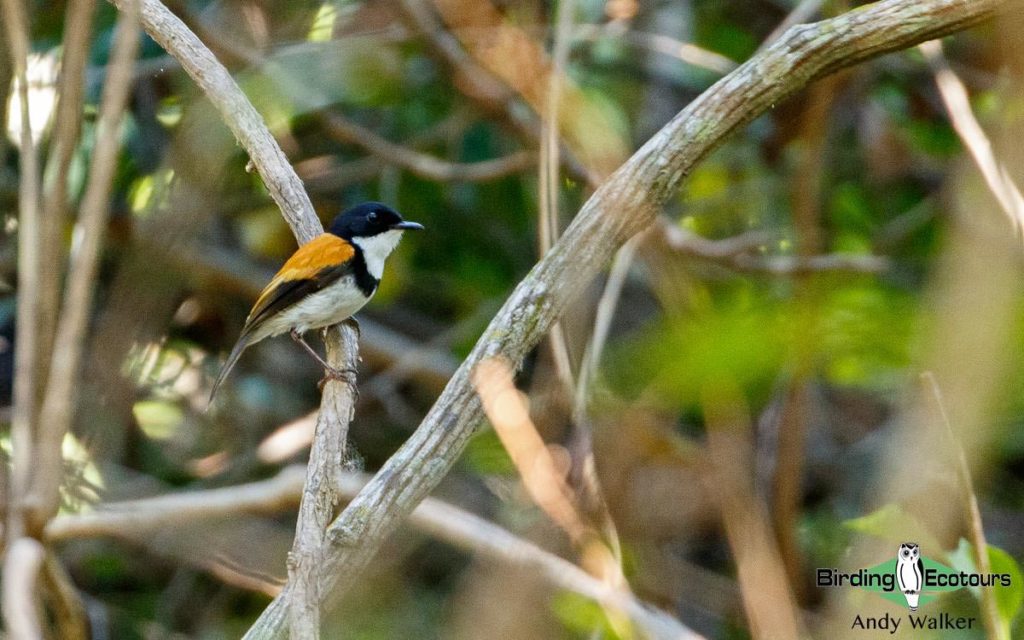
Day 10, 29th June 2022. Soé to Camplong to Kupang
We headed back to the forest near our accommodation but were greeted by further rain showers, but at least the wind had died down. We found some fruiting and flowering trees, complete with Streak-breasted Honeyeater, Black-breasted (Sumba) Myzomela, Short-tailed Starling, and Rose-crowned Fruit Dove. The rain increased and became persistent and continued for the rest of the morning, making birding very difficult. A few in the group managed to get their eyes on Buff-banded (Timor) Thicketbird, Timor Stubtail, and Cinnamon-banded Kingfisher, but conditions were very tough! In the afternoon we drove from Soé down to Kupang calling in at Camplong along the way. Luckily, we finally got a break in the rain for an hour and enjoyed a few birds, including Orange-sided Thrush, Rose-crowned Fruit Dove, Buff-banded (Timor) Thicketbird (finally seen!), Rainbow Bee-eater, Little Pied Flycatcher, and a few other species.
Day 11, 30th June 2022. Kupang to Mali (Alor)
A travel and cultural rain-affected day. We enjoyed a relaxed breakfast in our comfortable hotel in Kupang before flying north from Timor to Mali, on the island of Alor. After lunch enjoying great views of the bay, we made our way to a local traditional village for some cultural activities however a heavy rain deluge resulted in a premature end to the day.
Day 12, 1st July 2022. Birding Alor
A long and tiring day with an early start and late finish, but our first dry one in a few days. We took the long and bumpy road from our accommodation on the coast up into the little-visited mountains of Alor, where we searched for and found our main target bird, Alor Myzomela, a scarce single-island endemic, and an attractive one at that. We also enjoyed amazing looks at Flores Hawk-Eagle as one flew low overhead in the morning sun.
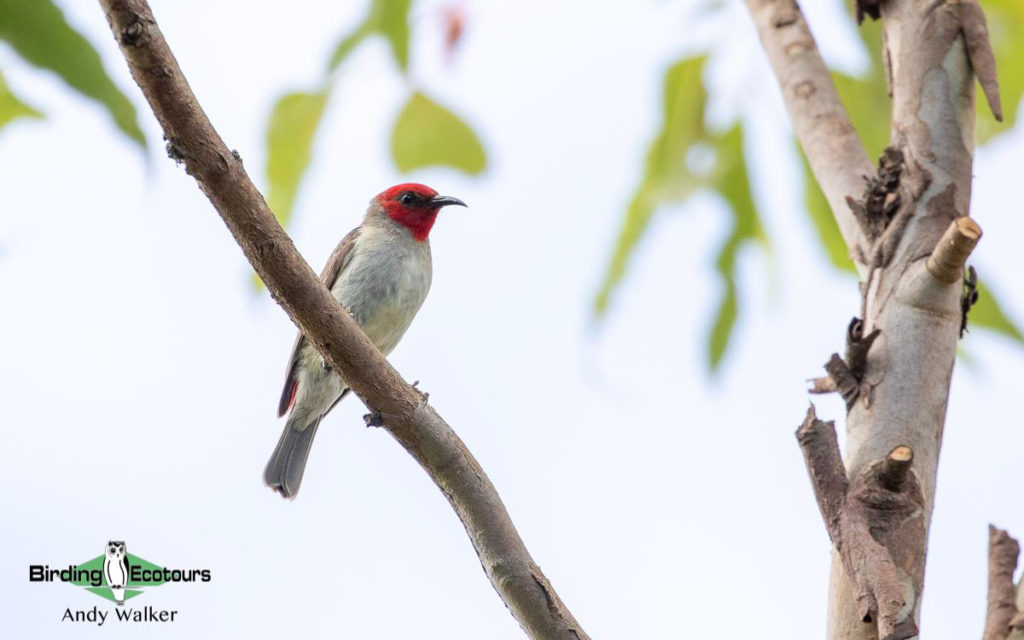
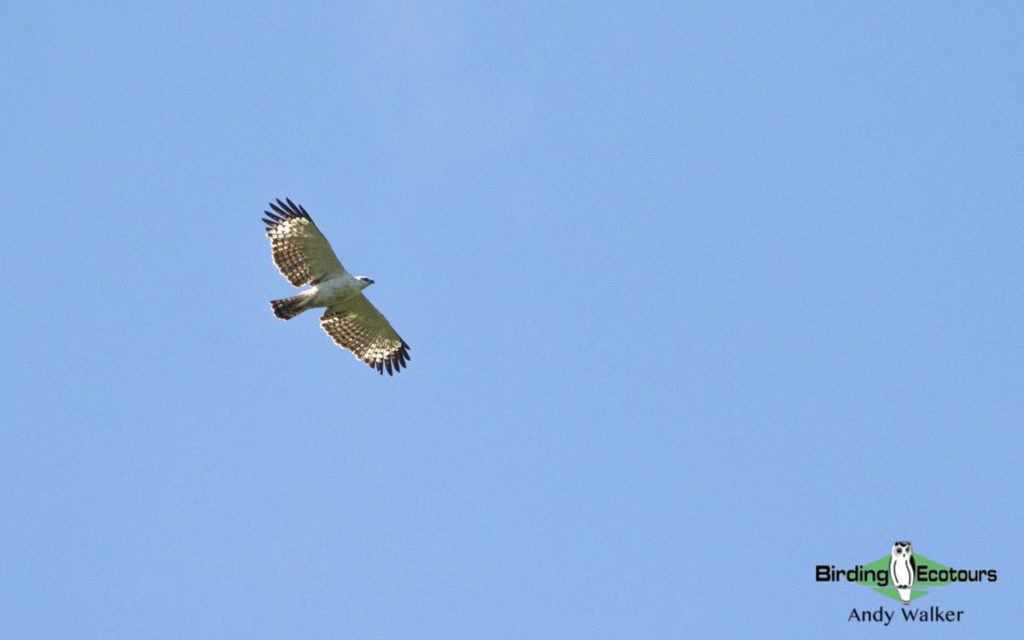
Other birds noted during our time birding in the mountains of Alor included Timor Cuckoo-Dove, Wallacean (Alor) Cuckooshrike, Wallacean (Flores Spangled) Drongo, Olive-headed Lorikeet, Helmeted (Tenggara) Friarbird, Black-fronted Flowerpecker, Red-backed Buttonquail, and further looks at perched Flores Hawk-Eagle, first distantly then much closer giving great views. In the evening we tried for Alor Boobook, a couple of birds were heard but just as one appeared to be coming close to us a convoy of noisy motorbikes went past and the opportunity seemed to go as the bird wouldn’t come back in. Frustratingly, it remained “heard only” apart from a possible fly through seen by a couple in the party.
Day 13, 2nd July 2022. Alor to Kupang, birding Bipolo Forest
A travel morning as we flew from Mali, Alor back to Kupang, Timor. In the afternoon we headed out to Bipolo Forest, where a gentle late-afternoon stroll yielded Timor Friarbird, Streak-breasted Honeyeater, Olive-headed Lorikeet, Northern (Timor) Fantail, and Arafura (Supertramp) Fantail. While scanning the nearby rice paddies and enjoying a large number of foraging Rainbow Bee-eaters, we picked up Black-faced Munia, Sunda Zebra Finch, and best of all, a single Timor Sparrow. Both Brown Goshawk and White-bellied Sea Eagle flew over as the sun was fading away and shortly after we were watching a fine-looking Timor Boobook, a great end to the day.

Day 14, 3rd July 2022. Kupang to Bajawa (Flores)
We enjoyed a relaxed breakfast in our hotel in Kupang before making our way the short distance to the airport for our morning flight to Bajawa in Flores, however the flight was delayed by an hour or so, meaning we eventually arrived later than planned. After lunch in Bajawa, we made our way to our new accommodation for the night before fitting in a short birding session in the late afternoon, which was actually quite rewarding (despite the low cloud). Here we found Leaf Lorikeet, Wallacean (Flores) Cuckooshrike, Thick-billed Heleia, Yellow-ringed White-eye (Wallace’s Heleia), Lemon-bellied White-eye, Ashy-bellied (Flores) White-eye, Warbling White-eye, Golden-rumped Flowerpecker, Flame-breasted Sunbird, and Little (Flores) Minivet.
Day 15, 4th July 2022. Bajawa to Ruteng, via Kisol and Taman Wisata Alam Rana Mese
We left Bajawa early to drive towards Kisol on the south coast of Flores. We spent the morning birding a patch of forest that was promising but birds were hard to see, moving quickly through the area, but included Glittering (White-rumped) Kingfisher, Spectacled Monarch, Rusty-breasted Whistler, Sunda Pygmy Woodpecker, Helmeted (Tenggara) Friarbird, Little (Flores) Minivet, Wallacean (Flores Spangled) Drongo, Black-fronted Flowerpecker, and Sunda Zebra Finch. Three of the better birds included Ornate Pitta, which perched up allowing nice eye-level views, a pair of vocal Flores Crows, and a few in the group got another sighting of Flores Hawk-Eagle.
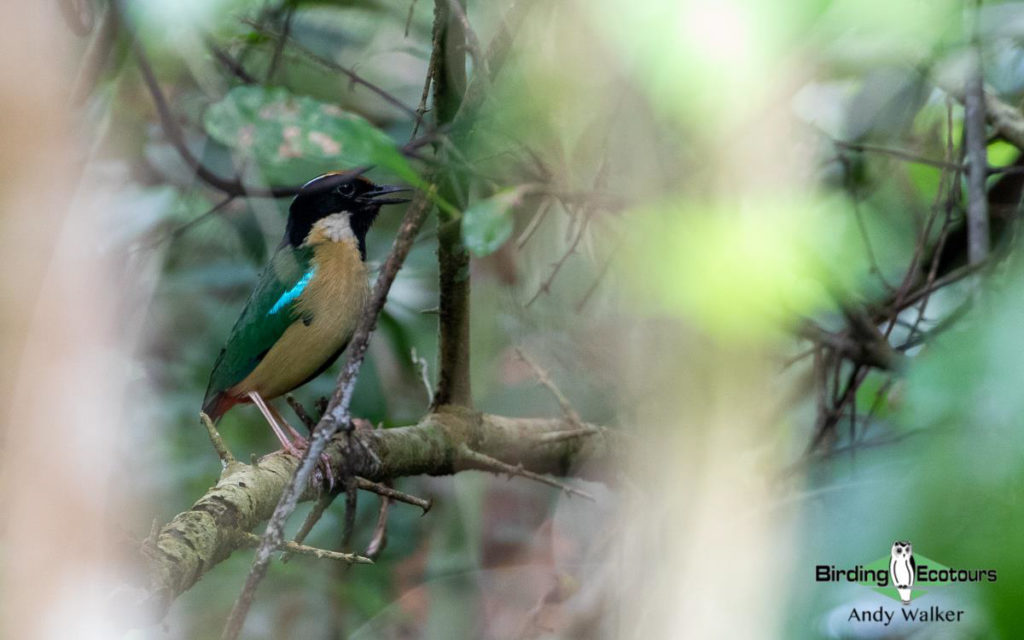
We took our lunch in a restaurant in the rice paddies and while waiting for our food we took in views of Black-faced Munia, Pale-headed Munia, Sacred Kingfisher, Black-fronted Flowerpecker, Striated Swallow, Intermediate Egret, Eastern Cattle Egret, Javan Pond Heron, and Little Egret.
During the afternoon we completed our drive to Ruteng, our base of the next two nights, but along the way we called in at Taman Wisata Alam Rana Mese where we found Pacific Black Duck and Tricolored Grebe on the lake. The trees around the lake were holding a mixed flock that included Thick-billed Heleia, Crested White-eye, Ashy-bellied (Flores) White-eye, Warbling White-eye, Little (Flores) Minivet, Wallacean (Flores Spangled) Drongo, Sunda Pygmy Woodpecker, Flores Jungle Flycatcher, Brown-capped (Trumpeting) Fantail, and Scaly-crowned Honeyeater. Wallace’s Scops Owls were making noise outside our rooms overnight for those still awake!
Day 16, 5th July 2022. Ruteng Birding including Golo Lusang
We spent the morning birding at Golo Lusang near Ruteng, where we found many great birds in a beautiful mountain setting. One of the most-popular birds of the morning was the male, singing, Bare-throated Whistler, what an absolutely stunning bird, and we had excellent views at eye-level too. Another highlight was the views we had of the usually secretive White-browed (Flores) Shortwing which also gave great views. Other goodies from the morning included Cream-browed White-eye (Heleia), Chestnut-backed Thrush, Little (Flores) Minivet, Flores Leaf Warbler, and Blood-breasted (Flores) Flowerpecker. Russet-capped Tesia and Pygmy Cupwings were heard but remained hidden.
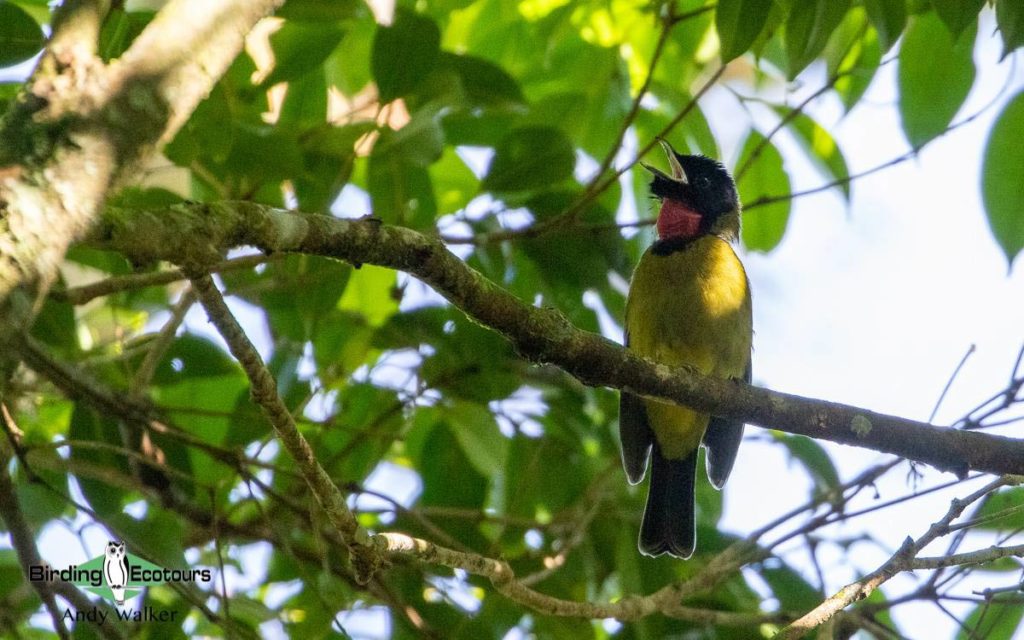
Afternoon birding near to Ruteng was also good, and we enjoyed seeing a Ruddy-breasted Crake walking across a track and improved our views of the attractive Glittering (White-rumped) Kingfisher while Russet-capped Tesia proved rather furtive again, just offering glimpses to a few of the group. A large fruiting tree and a mixed flock nearby gave some excitement with good looks at Chestnut-backed Thrush, Sunda Pygmy Woodpecker, Crested White-eye (Heleia), and Golden-rumped Flowerpecker. After dinner we tried our luck with the tough and scarce Flores Scops Owl, and we were rewarded with exceptional views after some patience listening to its insect/frog-like call.
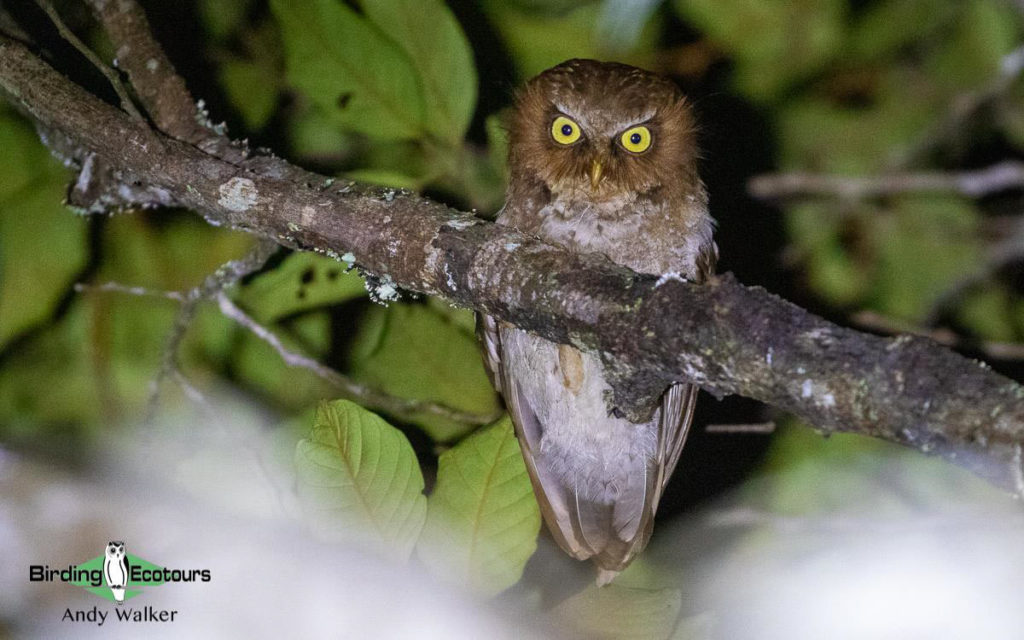
Day 17, 6th July 2022. Ruteng to Puarlolo
Leaving our accommodation in Ruteng after breakfast we drove out along a road with some decent adjacent forest and spent the morning working an area for a few targets. Two of the top birds seen here during the morning included the now rare Flores Green Pigeon and enigmatic Wallace’s Hanging Parrot. Plenty of other great birds were seen too, and included Ruddy (Parzudaki’s) Cuckoo-Dove, Red-cheeked Parrot, Tenggara Paradise Flycatcher, Wallacean (Flores Spangled) Drongo, Rufous-chested Flycatcher, Black-naped (Tenggara Golden) Oriole, Rusty-breasted Whistler, Little (Flores) Minivet, Flame-breasted Sunbird, Crested White-eye (Heleia), Sunda Pygmy Woodpecker, and we finally all saw (well) Russet-capped Tesia.
We dropped back in to Ruteng for lunch at our favorite restaurant of the tour and afterwards we commenced our drive to the Puarlolo area. Along the way we noted Black-winged Kite and Spotted Kestrel.
Arriving late in the afternoon, we had an hour birding at Puarlolo, here we got to grips with one of the tougher island endemics, Flores Monarch. Here too we saw a couple of secretive Chestnut-capped Thrushes, another showy Russet-capped Tesia, Little (Flores) Minivet, and a few more common species.
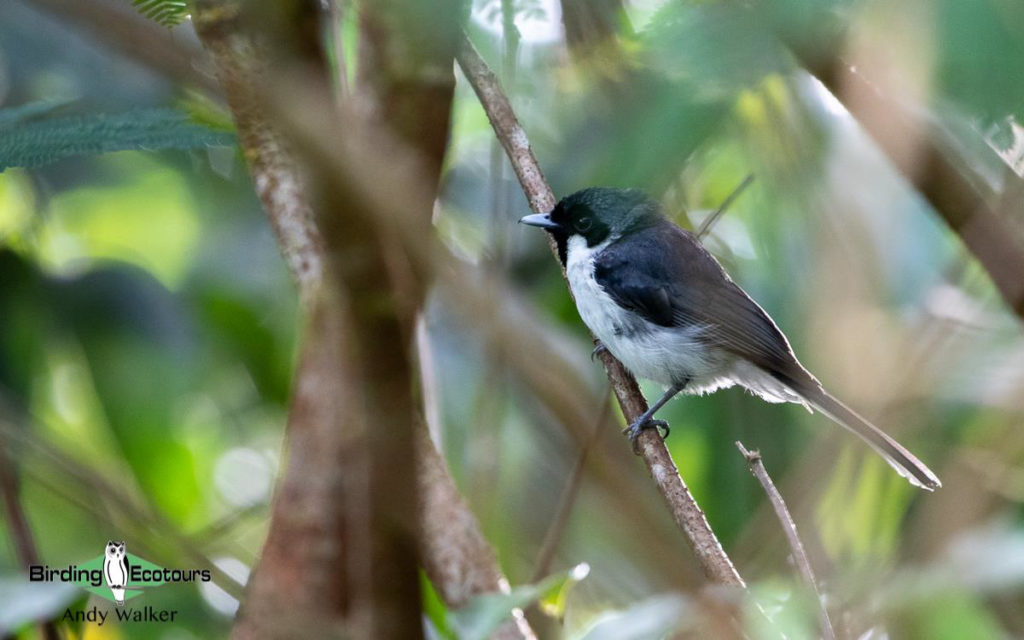
Day 18, 7th July 2022. Puarlolo to Labuan Bajo and on to Komodo Island
We spent the morning birding around the Puarlolo area where we got further views of the rapidly moving Flores Monarch, most of us getting better views than the previous evening. While we were trying to improve our views of the monarch, we found plenty of other good birds, which included Tenggara Paradise Flycatcher – a couple of stunning males chasing each other around, as well as Thick-billed Heleia, Yellow-ringed White-eye (Wallace’s Heleia), Crested White-eye (Heleia), Russet-capped Tesia, and Sunda PygmyWoodpecker.
In the late morning we drove down off the mountains into Labuan Bajo where we boarded our cabin boat for our overnight trip to Komodo Island. We enjoyed lunch on the boat in Labuan Bajo harbor before we commenced our rather relaxing four-hour journey to the island. Along the way we noted White-bellied Sea Eagle, Lesser Frigatebird, and Black-naped Tern as well as soaking in some impressive volcanic landscape.
Day 19, 8th July 2022. Komodo Island dragons and birding
After the night on our boat, we were up at first light to enjoy sunrise over Komodo Island. After a quick breakfast (the first of two breakfasts today!) we took a speedboat across to Komodo Island full of excitement at the prospects of what we might see. On arrival at the pier, we were greeted by a flock of around 100 Striated Swallows with a few Pacific Swallows thrown in too. After enjoying these, we met our local guides at the national park entrance and commenced our trek across part of the island. Our two main targets for the morning were Yellow-crested (Yellow-crested) Cockatoo and Komodo Dragon, and we got great views of both. Cockatoos were vocal and sitting in the tops of bare trees, showing their yellow crests. Our first dragon was a female, she didn’t show too well, moving through vegetation and away, though her size was impressive. Shortly after we found a huge male Komodo Dragon sunbathing, what a sight!
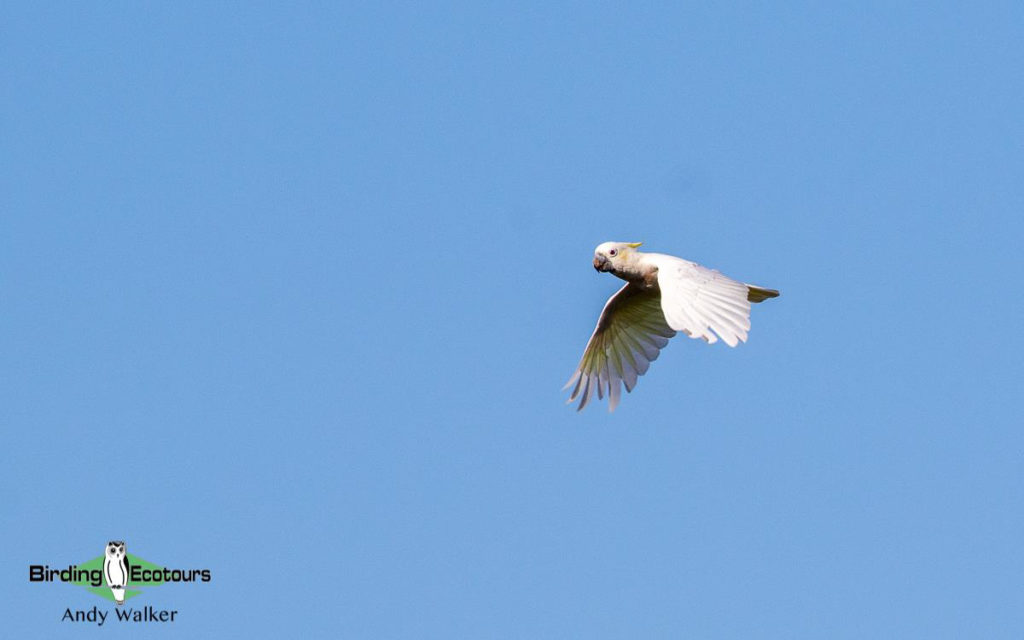

It was noticeable how differently the birds and wildlife behaved on the island, compared to the rest of Indonesia, with large birds sitting out unconcerned about getting shot at. We enjoyed watching Pied Imperial Pigeon, Green Imperial Pigeon, Sunda Collared Dove, Barred Dove, and (Eastern) Spotted Dove at close range, as well as getting great views of Wallacean (Flores) Cuckooshrike, Wallacean (Flores Spangled) Drongo, Black-naped (Tenggara Golden) Oriole, Helmeted (Tenggara) Friarbird, Green Junglefowl, and Orange-footed Scrubfowl along with plenty more.
After returning to our boat, we enjoyed second breakfast and set off back towards Labuan Bajo, stopping for some snorkeling and lunch along the way, before continuing our journey to the city, noting Bridled Tern, Black-naped Tern, and Great-billed Heron along the way. We then checked in to our beachside resort for the final two nights of the tour and spent some time relaxing, before a short owling session, where we saw Moluccan Scops Owl.
Day 20, 9th July 2022. Birding Labuan Bajo
We spent some time during the morning birding in a patch of forest near Labuan Bajo where we saw Red-cheeked Parrot, Black-naped Fruit Dove, Dark-backed Imperial Pigeon, Black-naped (Tenggara Golden) Oriole, and assorted other common birds of the area such as Wallacean (Flores) Drongo, Flame-breasted Sunbird, Brown-throated Sunbird, and Rusty-breasted Whistler.
We spent some time relaxing around our resort where the gardens were alive with birds, and included Lemon-bellied White-eye, Sunda Zebra Finch, Black-faced Munia, Common Emerald Dove, Sacred Kingfisher, Collared Kingfisher, and Golden-bellied Gerygone.
In the late afternoon we visited some shrimp ponds and rice paddies near our accommodation and there was quite a lot of activity with Cerulean Kingfisher, Stork-billed Kingfisher, Sacred Kingfisher, and Collared Kingfisher all seen, with other highlights including Buff-banded Rail, White-browed Crake, Australasian Swamphen, Bonelli’s Eagle, Sunda Teal, Black-faced Munia, and Blue-tailed Bee-eater.
Day 21, 10th July 2022. Labuan Bajo to Denpasar (Bali)
After a relaxing morning around our beachside resort grounds enjoying the many birds in the garden, we flew from Labuan Bajo back to Denpasar, Bali where the tour concluded.
A huge thank you to Yovie for his excellent guiding on the tour in sometimes difficult and unseasonable weather situations (the effects of La Niña were felt in Timor and Alor particularly) and an equally huge thank you to all participants for making the trip so enjoyable. Look forward to the next time!
For the first time ever on a tour of mine everyone had a different “Bird of the Trip”, these being Flores Monarch, Sumba Hornbill, Flores Scops Owl, Bare-throated Whistler, Red-naped Fruit Dove, and Ornate Pitta, a fine selection of birds and goes to show the number of top quality birds we saw!
DOWNLOAD TRIP REPORT
Please see the downloadable PDF above with the full species lists included. This is a sample trip report. Please email us ([email protected]) for more trip reports from this destination.
Indonesia: The Lesser Sunda Islands – Comprehensive Tour
Tour-Specific Information
GENERAL INFORMATION ABOUT INDONESIA CAN BE READ HERE
TOUR OUTLINE
This is an amazing opportunity to connect with numerous thrilling regional and island-endemic birds as we cover the Lesser Sunda islands of Sumba, Timor, Rote, Alor, Flores, and Komodo (with a start and end point of Denpasar, Bali “The Islands of the Gods”). This is a comprehensive tour to an area not visited by many birders annually. We will find numerous endemic owls, such as Flores Scops Owl, Little Sumba Hawk-Owl, Rote Boobook, and Wallace’s Scops Owl (and more), alongside spectacular species such as Sumba Hornbill, Yellow-crested Cockatoo (of two subspecies), Bare-throated Whistler, Black-banded Flycatcher, Elegant Pitta, Ornate Pitta, and many more delights from a wide assortment of families like honeyeaters, kingfishers, parrots, pigeons, fruit doves, flycatchers, and thrushes. We will also be looking for Komodo Dragon, the world’s largest lizard on this tour. We should get good photo opportunities as we make our way around these little-visited islands.
DAILY ACTIVITIES, PHYSICAL REQUIREMENTS, AND TOUR PACE
This Indonesian birding tour through the Lesser Sunda islands needs reasonable fitness and is run at a moderate pace, covering a lot of remote ground. The tour is likely to be tiring due to the distances covered in remote areas and the heat to be expected, more on that in the “Weather/Climate” details below.
We will be visiting some remote areas on this tour, though will also be passing through towns and cities occasionally on our quest to find as many of the region’s special birds as possible. Remember we will be visiting a developing country and will be staying in remote areas, where there are limited sanitation facilities and services will be very different to what you might expect from home, or even other areas in Indonesia. Notwithstanding the above, we have tried to make this tour as comfortable as possible by staying in accommodation that we know well and is of the highest standard in the local area. Hopefully our time between birding sessions will be as comfortable and relaxing as possible. But some of the accommodation in some locations is rather basic, see more information in the “Accommodation” section below.
This tour entails multiple domestic flights and some boat trips (a mix of fast-ferries, live-aboard boats, and speedboats/outrigger boats). There are several long drives on the tour (e.g. some in the region of five hours), sometimes on poor roads and this can be tiring, particularly when the heat is added into the mix.
We will have long days in the field, though often, when the situation allows, we will rest during the heat of the middle of the day (when bird activity is lower). We will usually have an early breakfast (sometimes this will be a boxed breakfast) before we head out birding. Lunch will usually be back at our accommodation or a restaurant but occasionally might be ‘in the field’ as a boxed picnic lunch, this will very much depend on where we are birding. Dinner will most often be back at our accommodation or a nearby restaurant. There are a lot of nightbirds possible on this tour so there will be several night birding sessions either after dinner, or sometimes before dinner (with a later mealtime being on the cards). Note in some areas there are no facilities at all near birding areas (such as when we are birding on Rote), this is likely to result in a long day as we will have to leave our accommodation very early to get to the birding site for first light and may be out until after dark in the evening (after an endemic owling session), making do with boxed meals/snacks and a late dinner. There will also be no bathroom facilities for most of this day.
Most of our birding on this tour is carried out on flat or gently undulating roads, tracks, and trails, some of these are interspersed with short and steep inclines and declines, but nothing likely to be too problematic for most people in the main, and we will be going at a slow, birding pace. When we are birding in the mountains of central Flores, we will spend most of our time birding along roads. We will likely need to come “off-piste” in our search for some of the more secretive species unlikely to be seen right from the roads and this could include short sharp inclines and declines and sometimes boggy/slippery “trails”. Most of the lowland areas are likely to be very dry and rocky, sometimes we will need to walk through dry, rocky streambeds so care should be taken. Walking sticks or hiking poles are useful by providing additional stability to aid balance and are compulsory for anyone who is not steady on their feet. Most of the walks will be short and close to vehicles, a few walks will be longer but nothing likely to cause anyone any problems if proper hydration is maintained, due to the heat.
TRANSPORTATION AND SEAT ROTATION
We use several types of transport on the tour as we move around the region by land, sea, and air.
On land we will use a range of minibuses of varying sizes, sometimes 4×4 vehicles, such as a Toyota Hilux or similar, and sometimes a group of saloon cars, such as a Toyota Avanza or similar. During our time in vehicles, we will have a seat rotation policy in place, so that everyone on the tour has the same opportunities with seating positions. All participants will be expected to abide by the seat rotation policy. People suffering from motion sickness will not be excused from this policy, so please make sure you have any medication you might need. We will be driving along windy and rough roads in places. We require that you are fit and flexible and can maneuver yourself into and around the vehicles.
We will take multiple domestic flights on this tour (see “Domestic Flights” below, for specifics).
We will potentially use a fast-ferry to move between Timor and Rote (or vice versa) depending on flight schedules, which are subject to changes beyond our control. We will have airplane-style seats and be in an air-conditioned section of the boat and the trip would take up to two hours. We will spend one night on a live-aboard boat for our trip to the Komodo Islands, we will have air-conditioned cabins (see “Boat to Komodo Island” section below).
DOMESTIC FLIGHTS
This bird tour starts and ends in Denpasar, Bali, however there are multiple domestic flights required. Please refer to the tour map tab for a visualization of the tour route. The flights are anticipated to be as follows: Bali-Sumba, Sumba-Timor-Rote, Rote-Timor, Timor-Alor, Alor-Timor, Timor-Flores, and Flores-Bali assuming the flight schedule works for our needs. We may need to substitute in a fast-ferry boat trip between Rote and Timor and we will monitor flight schedules as they can change without warning.
Note that the costs for the domestic flights are included in the tour costs, but the cost for hold luggage is not included in the ticket costs. We estimate this to be in the region of between US$150 – US$200 per person and will need to be paid for at the airport in Indonesian Rupiah (IDR) cash. We will update you two months before the tour as to current estimated prices in case of any unexpected changes. You will need at least between Rp1,500,000 – 2,000,000 per person for hold baggage costs. See “Money” section below.
Most providers have a weight limit of 44 pounds (20 kilograms) and a hand luggage weight limit of 15 pounds (7 kilograms). Any overweight baggage will invite additional costs by the airline used and will be the responsibility of the individual to pay (in cash) while at the airport. Making excess baggage payments at the various airports is likely to take extra time and cause delays to the group, so adhering to the baggage allowance is best for everyone.
BOAT TO KOMODO ISLAND
We will have an overnight trip on a boat to Komodo Island, likely one of the boats here, the exact boat we use will be determined by our final group size and availability. If you would like additional information on the boat closer to the time of the tour, please let us know.
LUGGAGE
Please note the expected maximum weight allowances for the domestic flights and please therefore pack as lightly as possible. A medium, soft-sided, strong duffle bag (not the hard sided cases) is likely to work best for packing in the tour vehicles (noting that this will likely include minibuses, 4×4 vehicles, ferries, live-aboard boats, speedboats, and planes). We recommend a daypack is used to keep items that you wish to use daily when in the vehicle, in the field, and for hand luggage when flying, this should be of the standard size that fits into overhead luggage compartments in planes.
SAFETY
Your safety is our paramount importance on this tour, that’s why we try and provide you with as much thorough general and tour-specific information as possible.
Care should be taken when in cities, airports, and ports where petty theft (e.g. pickpockets etc.) could occur.
Trips and falls when on trails, tracks/roads, rocky, dry riverbeds, and while getting into or out of the vehicles or boats are all possibilities on this tour and care should be taken, especially when conditions are rocky, boggy, or slippery. A walking stick of hiking pole is compulsory if you are at all unsure on your feet. Note we will, at times, venture off marked trails/roads in pursuit of certain target birds and these may include steep inclines or declines.
Natural disasters such as earthquakes, tsunamis, volcanoes, and flooding are frequent across Indonesia. We will keep abreast of the situation ahead of, and during the tour. Be aware that a volcanic eruption far away from the tour location can cause flight delays, for example should a volcano erupt in or near the Indonesian international airports in Bali or Java.
Insect repellent with a high DEET concentration can be useful for keeping Mosquitoes away. The islands we will be visiting have a low Malaria risk, but prevention of bites is recommended, and please consult your doctor or travel health specialist for current information. We would recommend using an insect spray with a high DEET level as it can also keep chiggers and leeches away. Chiggers, possible at a couple of locations, can lead to Scrub (Bush) Typhus and can be seriously irritant as well as lead to medical issues. Leeches, possible in wet areas, like the mountains of Flores, do not spread diseases, but they are annoying and can cause blood loss. Rubber boots can help with reducing issues with chiggers and leeches.
Please follow any safety information from our boat crew on our Komodo Island trip. Care should be taken when swimming and snorkeling. The underwater life is interesting, but it does come with some dangers. We recommend you familiarize yourselves with seriously dangerous creatures such the (Sea Wasp) Australian Box Jellyfish and “Blue-ringed Octopus”.
While on Komodo Island we will be in the realm of the massive Komodo Dragon which is the world’s largest and heaviest lizard, weighing in at a staggering 200 pounds (90 kilograms) and measuring up to a whopping ten feet/three meters! Some have even been recorded with a weight of 330 pounds (150 kilograms)! Komodo Dragons should be treated with total respect, they have venom glands loaded with toxins that lower blood pressure, cause massive bleeding, prevent clotting, and induce shock. They bite down with serrated teeth and pull back with powerful neck muscles, resulting in huge gaping wounds. The venom then quickens the loss of blood and sends the prey into shock. Dragons can calmly follow an escapee for miles as the venom takes effect, using their keen sense of smell to locate the corpse. Read more from National Geographic on these amazing living dinosaurs, here. Our time on Komodo Island will be carefully managed by national park staff and the safety of visitors is one of their main concerns.
WEATHER/CLIMATE
We can expect the weather on the tour to mainly be hot and dry, while when we are birding in forests it may feel more humid. Most of the birding is carried out in the lowlands of Sumba, Rote, Alor, and Komodo where we can expect daytime temperatures of around 85–91 °F (30–33 °C) and nighttime temperatures of around 69–72 °F (20–22 °C). When in the lowlands of Flores and Timor the same can be expected, however on both of these islands we will also spend some time birding at higher elevations, e.g. up to 6,000 feet (1,800 meters) on Timor up to 8,200 feet (2,500 meters) on Flores. Here we can expect lower temperatures, though apart from very early morning it isn’t really that much colder, and our accommodation will be located lower than the birding areas so not quite as cold as the birding sites. While birding at these higher elevations, we can expect temperatures of around 70–75 °F (21–23 °C) during the day and temperatures of around 50–60 °F (10–16 °C) at night. We can sometimes experience winds that might make temperatures feel hotter than they actually are (the opposite to a wind chill!). Rain showers are unlikely, though always possible, particularly when we are in the mountains on Flores.
The sun gets very hot, very quickly in the morning and it is imperative that hydration levels are maintained, and sunscreen applied from early in the day.
ACCOMMODATION
We will stay in a range of accommodation during the tour and the majority of this is comfortable, though one night in Sumba will be in very basic accommodation (this is a necessity to bird the area we want to explore for the best chance of the endemic forest birds of the island). All accommodation will have air conditioning and/or a ceiling or standing fan (with the exception of the one night in remote Sumba). Most accommodation will have Wi-Fi and the majority (with the exception of all on Sumba) will be in areas with phone signal. Some Wi-Fi might be restricted to public areas, such as restaurants. All rooms will have ensuite facilities with western toilet facilities. Some bathrooms (e.g. in Rote) may be of the “wet-room” style commonly found throughout Asia. We will be spending one night on a live-aboard boat as we travel to Komodo Island (see the “Boat to Komodo Island” section above for specific information on that).
We are visiting multiple islands on this tour, some of the accommodation is very close to birding sites and others are a little further away (due to the remote nature of where we are going). On some days we will have to drive one hour from our accommodation to where we want to be birding, and on some days (like while birding on Rote) we might have to drive over two hours from our accommodation – which is the closest option currently based on exploration of the area in October 2021).
COMMUNICATIONS
There is phone signal across much of the tour route though there are some areas where there is no, or very limited signal. The phone signal in Sumba is very poor, even in the towns, where we stay overnight, and where we go birding. Most of the other islands have better connections. The easiest option will be to use your phone on an international roaming package. It will be possible to purchase and use a local SIM, but because we will be visiting multiple islands it will entail quite a lot of faff and is not really recommended, unless totally essential, though we can help guide you if you want to go down this route. It will definitely be easier to rely on Wi-Fi in the various accommodations we stay at. Most airports we visit will have free Wi-Fi.
FOOD AND MEALS
The food during the tour will be of local Indonesian style. In some of the areas we visit (such as when we are in the larger cities and tourist areas) we will be able to get western style food, but this is only on a couple of days, the majority of food will be local. Bringing cereal bars (or energy/protein bars) might be useful for during early mornings or during a long drive, when a snack is required. Some of the places we visit on this tour are remote with limited, or no, convenience stores. It is actually recommended that if you have particular preferences of snacks, you bring them with you from home as we will have limited opportunities for picking up recognizable snacks on the tour, though in some areas we will be able to make use of great bakeries.
Due to the nature of the birding on this tour (outlined in the “Daily Activities, Physical Requirements, and Tour Pace” section above), meals will be at a range of times, sometimes early or late breakfasts and early or late evening meals and will be dictated by the birding or traveling occurring in the day/night. We may get a sit-down breakfast on some occasions and at other times these may be boxed and rather basic (again, we will be going to remote areas and fancy food is not really a feature of most of this tour). On some occasions we will have lunch back at our accommodation or a nearby local warung (local restaurant), though we might also have a picnic-style boxed lunch. Many of the meals will involve an assortment of meat (mainly chicken and fish, occasionally beef and seafood) and vegetable dishes. There will be a hearty supply of rice and noodles with most lunches and evening dinners. A selection of food will usually be placed in the center of the table and shared by the group. Us knowing your dietary preferences ahead of the tour is essential, so please fill us in on anything we should know.
If you must eat food at certain times, for medical reasons for example, please bring a supply of snacks to do so because we cannot guarantee set mealtimes on this birding-focused tour.
MONEY
Important Note: You will need at least between Rp1,500,000 – 2,000,000 per person for hold baggage costs that are not included within the tour costs.
It is recommended that you either bring a supply of Indonesian rupiah with you from home or withdraw some cash from the international airport that you arrive at (such as Bali’s Ngurah Rai International Airport, where the tour starts from). There should be opportunities to withdraw cash, if needed when in Bali (at the airport), Kupang (Timor), Ruteng (Flores), and Labuan Bajo (Flores). It is unlikely that there will be opportunities to withdraw cash while on Rote, Alor, or while in more remote areas of Timor and Flores. There are no facilities on Komodo Island.
It is not uncommon to have difficulties trying to use ATMs in some of the more remote areas and small towns. Not all banks/ATMs accept all foreign cards, most are usually limited to a withdrawal maximum of Rp2,000,000 in one go. Most international bank cards will incur a fee for taking cash from the ATMs.
Most extra purchases/personal expenses are likely to require payment by cash, with the exception of hotels in major cities where cards should be fine to be accepted. Note it is not uncommon for card payment machines, even in major towns and cities, to not work due to problems with the phone line, the internet connection, or other issues.
WHAT TO BRING: CLOTHING AND OTHER ITEMS
The following is a list of useful items to bring on this birding tour around the Lesser Sunda Islands and should be read in conjunction with the general information document for Indonesia.
- A field guide to the region. The following book is best for this tour: Birds of the Indonesian Archipelago: Greater Sundas and Wallacea – James A Eaton et al. (2021), Lynx Edicions. 2nd Edition. The Flexibound version of the 2nd edition of this book is best, rather than the hardback or outdated 1st edition versions that are also available.
- A walking stick or a hiking pole to help on the slippery or rocky tracks and trails. A walking stick is compulsory for anyone who is unsteady walking, as we feel this is a safety issue; we do not want anyone falling over. Uncertain if you need one? Please consult with us.
- Flashlight (torch) and/or a headlamp, and spare batteries/chargers – essential kit for this tour as we will be having multiple owling sessions with endemic owls being found on all main islands we visit. We will have spotlights for observing the birds, but you will need something small so that you can see where you are putting your hands and feet as we walk around, sometimes on roads and trails, sometimes while bushwhacking.
- High concentration DEET insect repellant.
- Leech socks – useful, particularly if it is wet (rubber boots might work) and when owling at night, e.g. on Flores when it’s not as easy to see what’s going on.
- A small personal first aid kit. See the suggested items from the Centers for Disease Control and Prevention (CDC), here. There are pharmacies in all cities we will pass through, but we will only have limited time and access to these.
- Walking/hiking boots are probably best for this tour as they provide good ankle support. Rubber boots can be useful but likely only when birding in the mountains of Flores, so probably not worth bringing for the whole tour, though they can help with keeping leeches or chiggers at bay (but leech socks should be sufficient here).
- Clothes made with a quick-drying fabric are the best for this tour (see the “Weather/Climate” section for further information on likely temperatures during the tour). You are likely to get sweaty and so rinsing out clothes might be needed. Laundry facilities will be very limited on this tour. A fleece can be useful/necessary when birding at the higher elevation sites such as on Flores, and less so on Timor (mainly in the early morning period).
- Rain jacket (and small umbrella) for the time in the mountains when rain could be possible. A dry bag to keep important documents in.
- Swimwear, mask, and snorkel for optional swimming during our Komodo Island boat trip. Note the boat we use has snorkeling equipment to hire (hire costs to be paid in Indonesian rupiah, cash).
- Power bank – useful for keeping cell phones charged up, or if there are any unexpected power cuts while in remote areas.
‘For anyone interested in the extraordinary diversity of Indonesian birds, this tour provides a wonderful opportunity to see the many endemic species on six of the islands of the Lesser Sundas. Thorough research and planning by Birding Ecotours will enable participants to see many, if not all of the endemic birds of each island and at a relatively relaxed pace.’
David and Barbara
